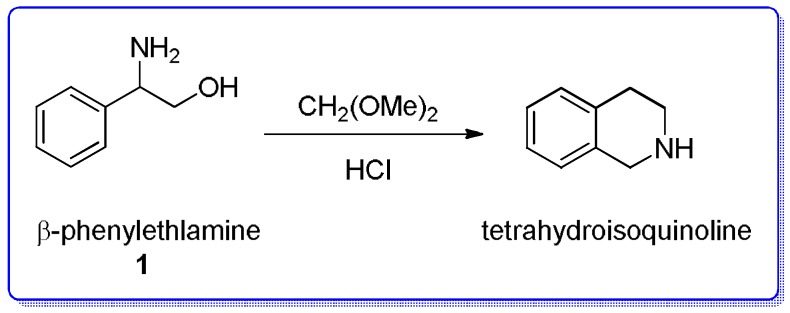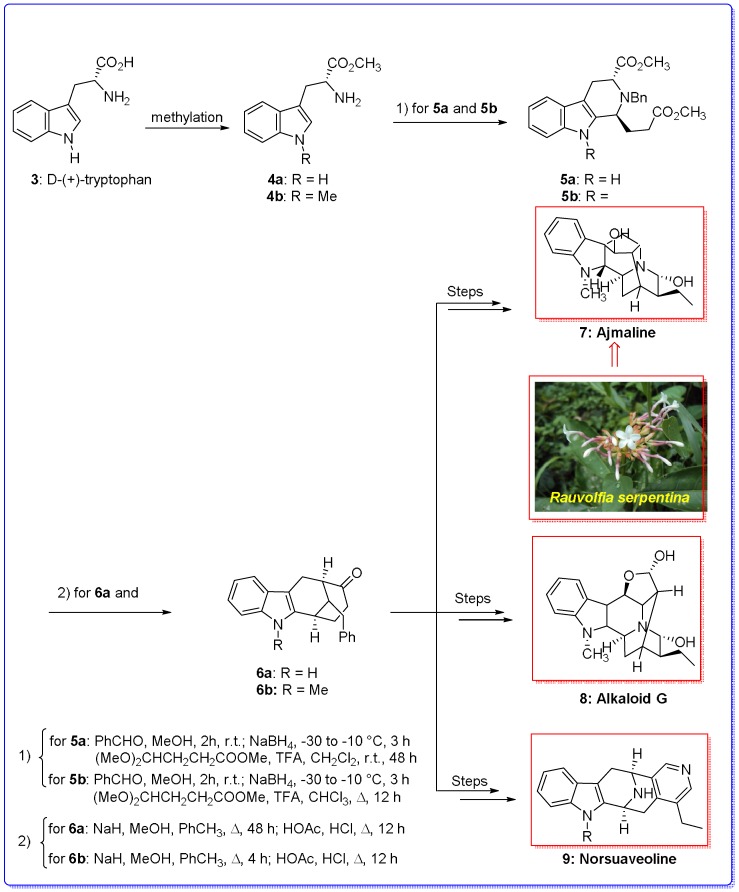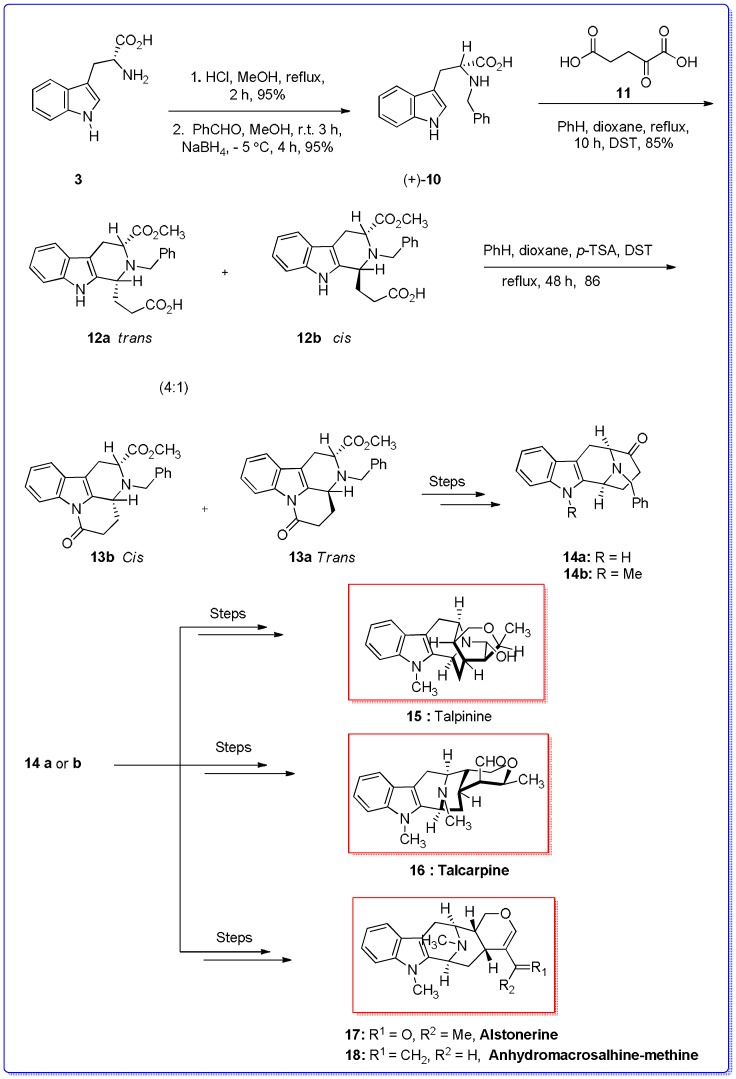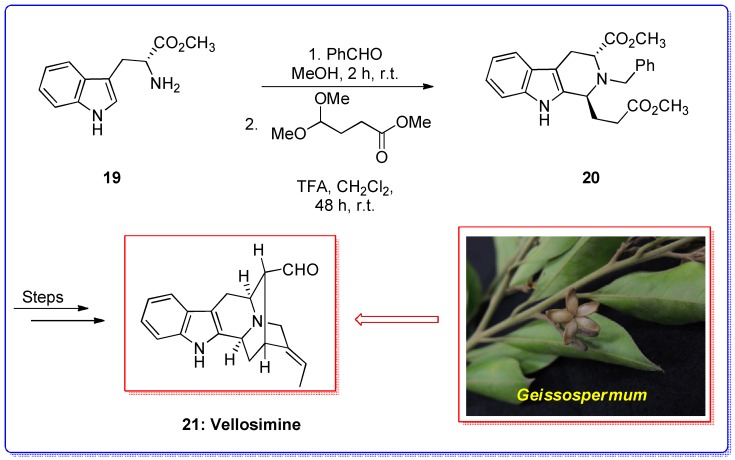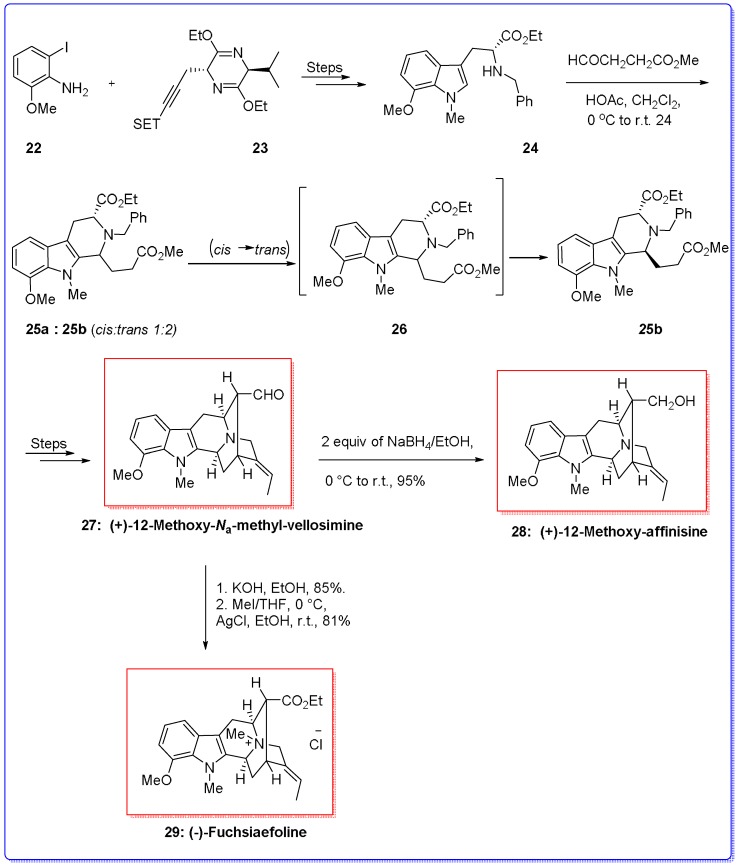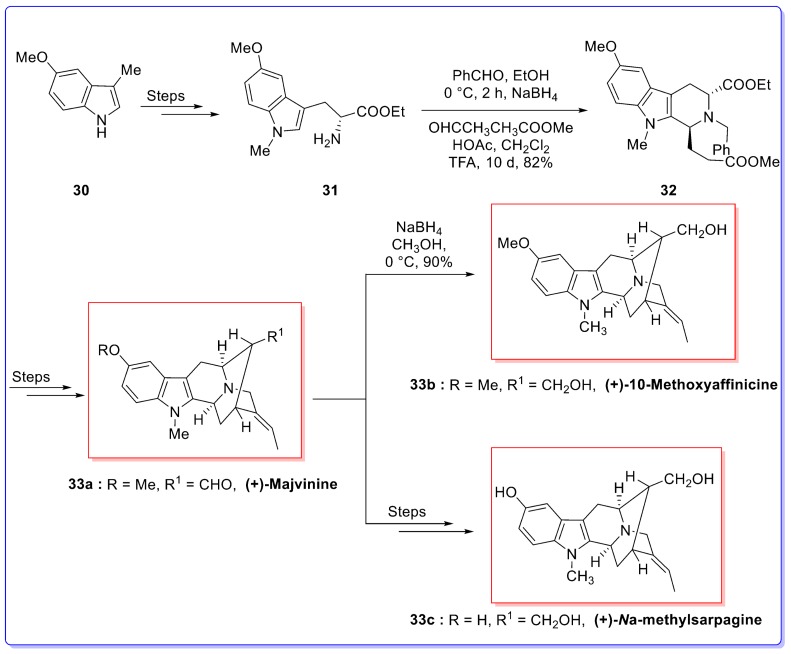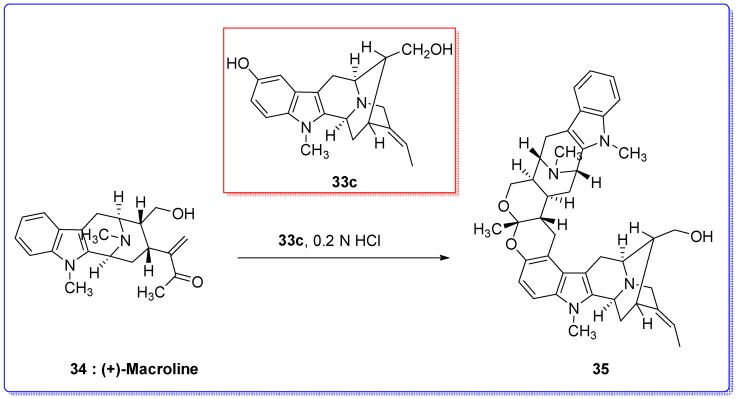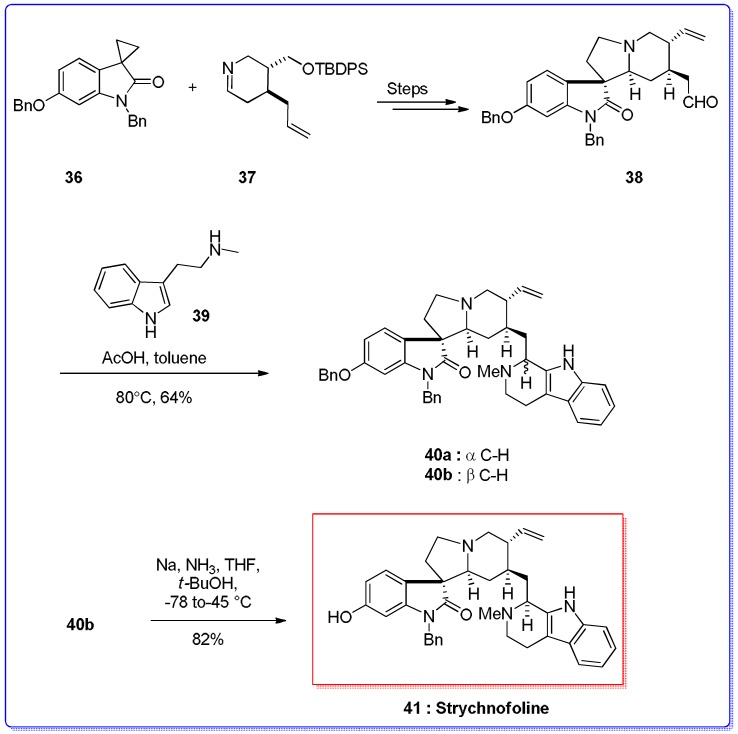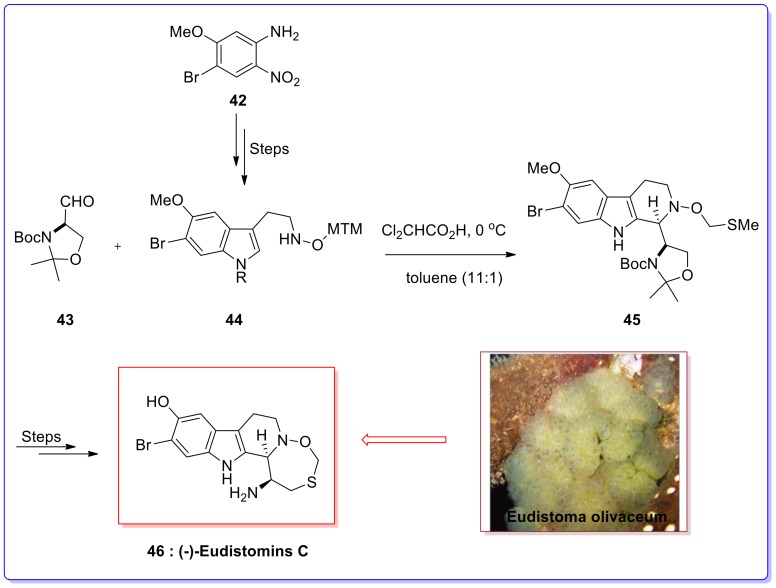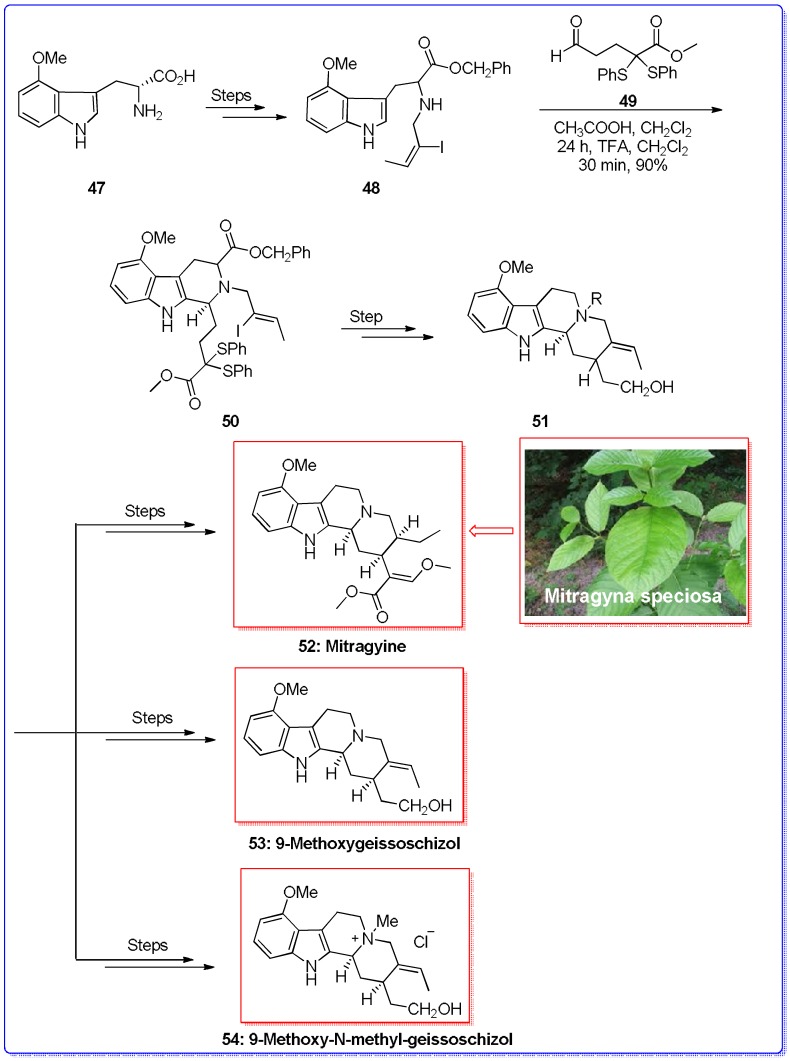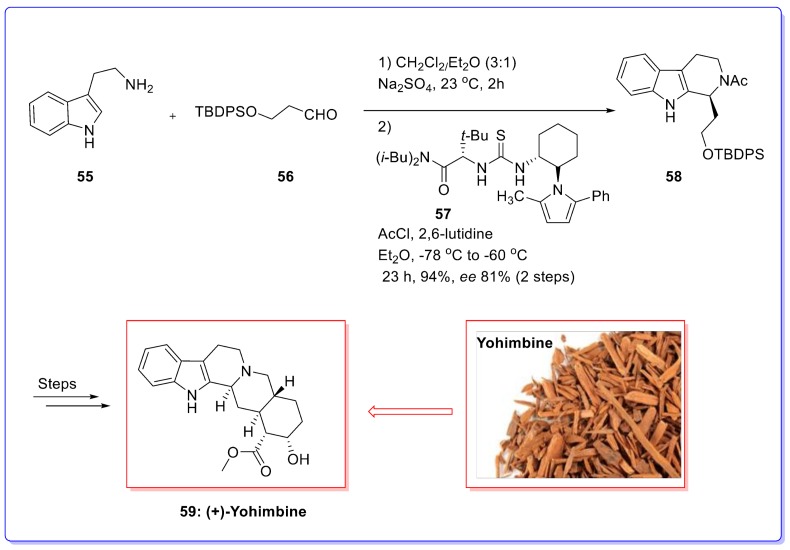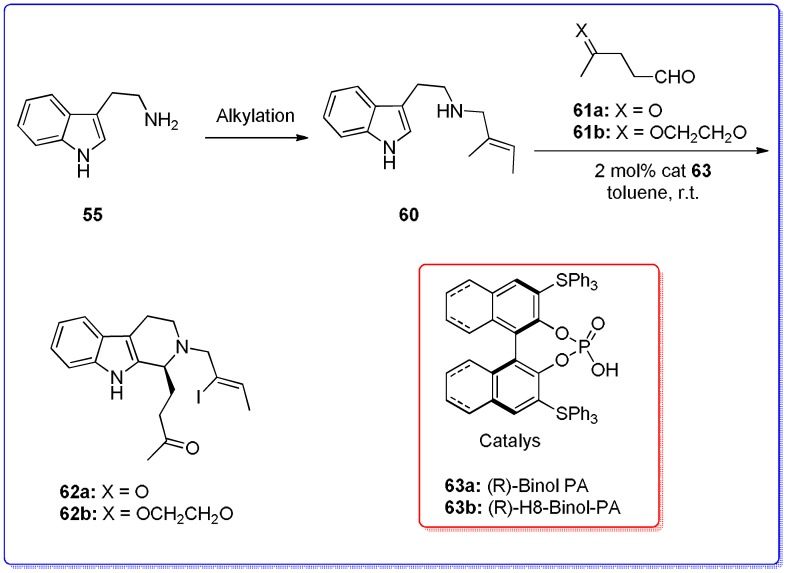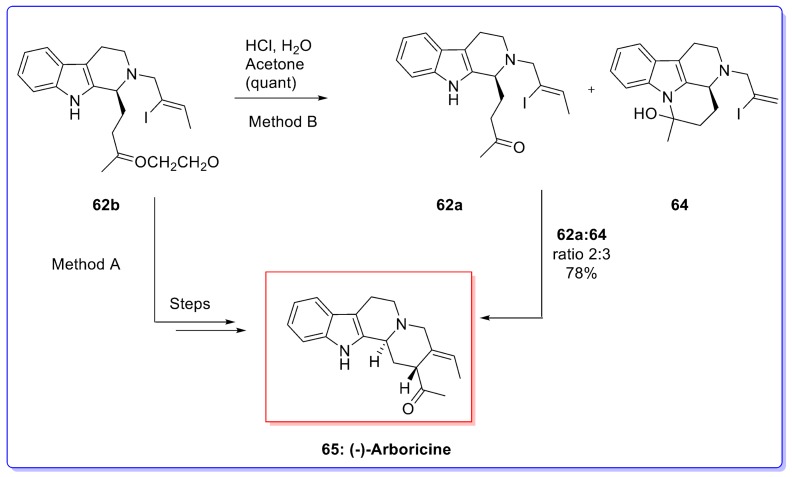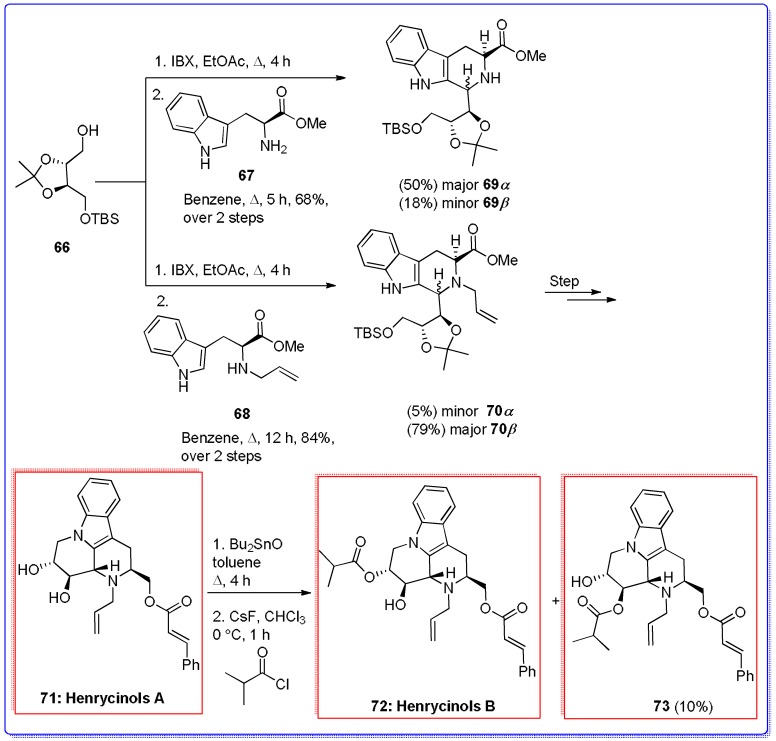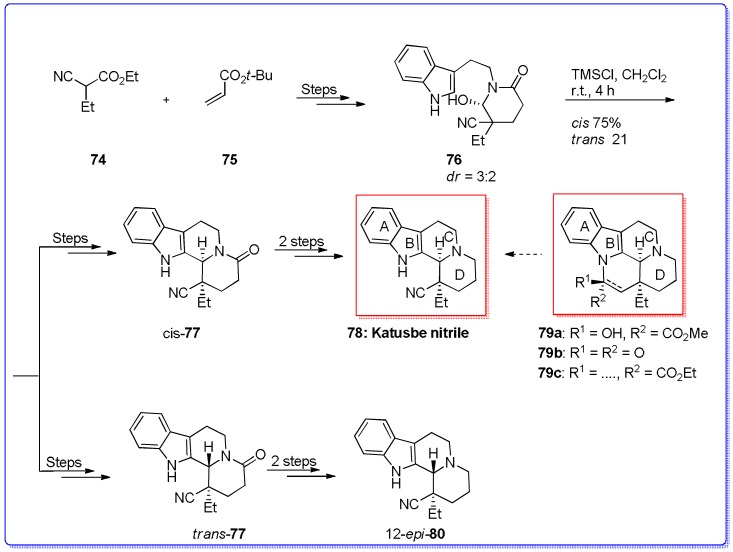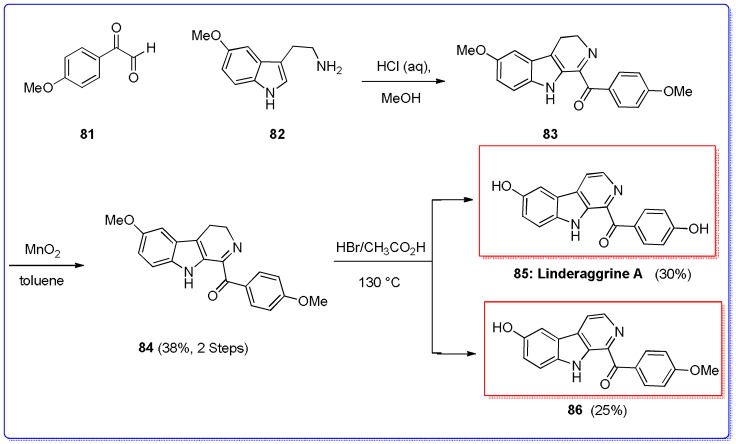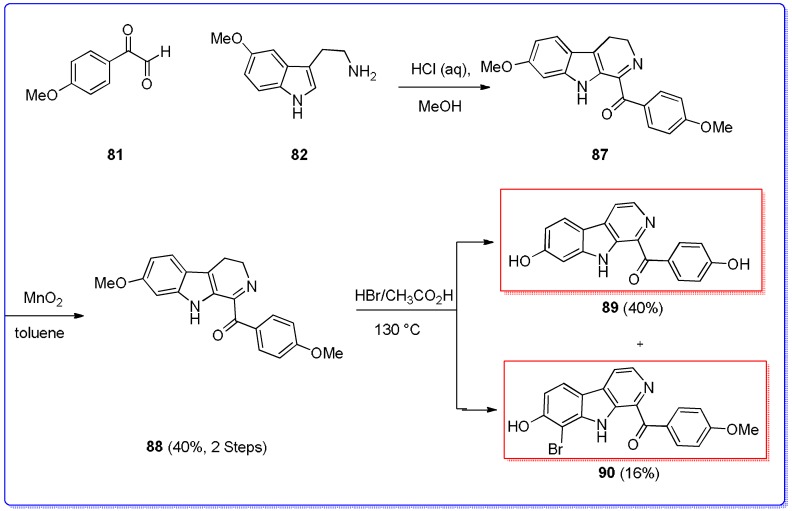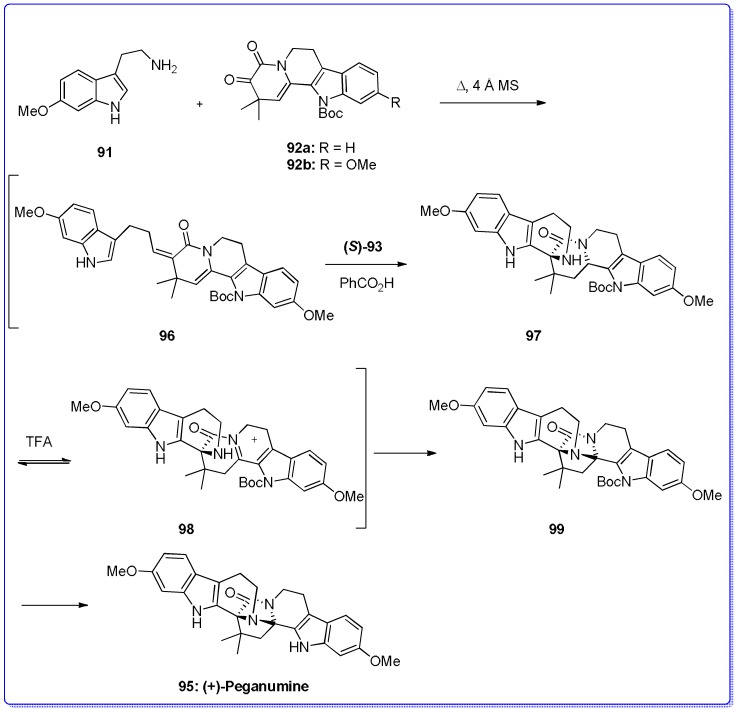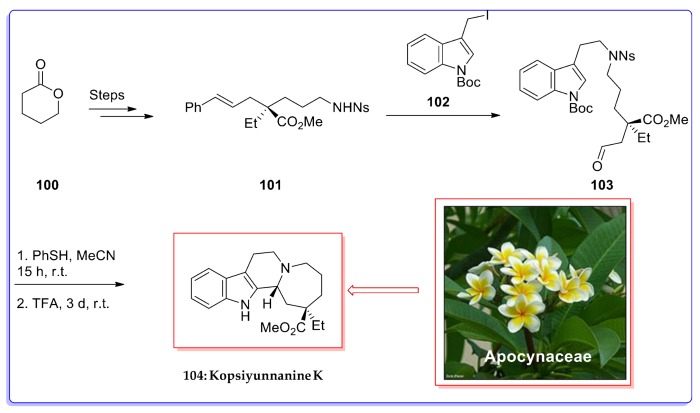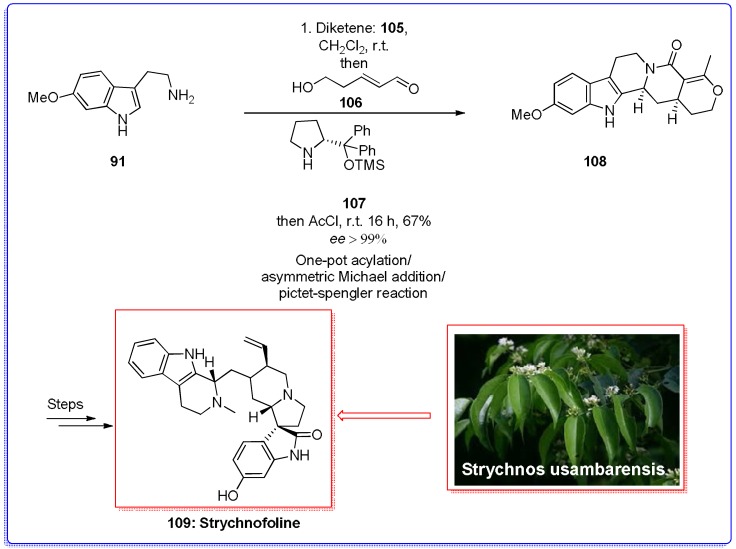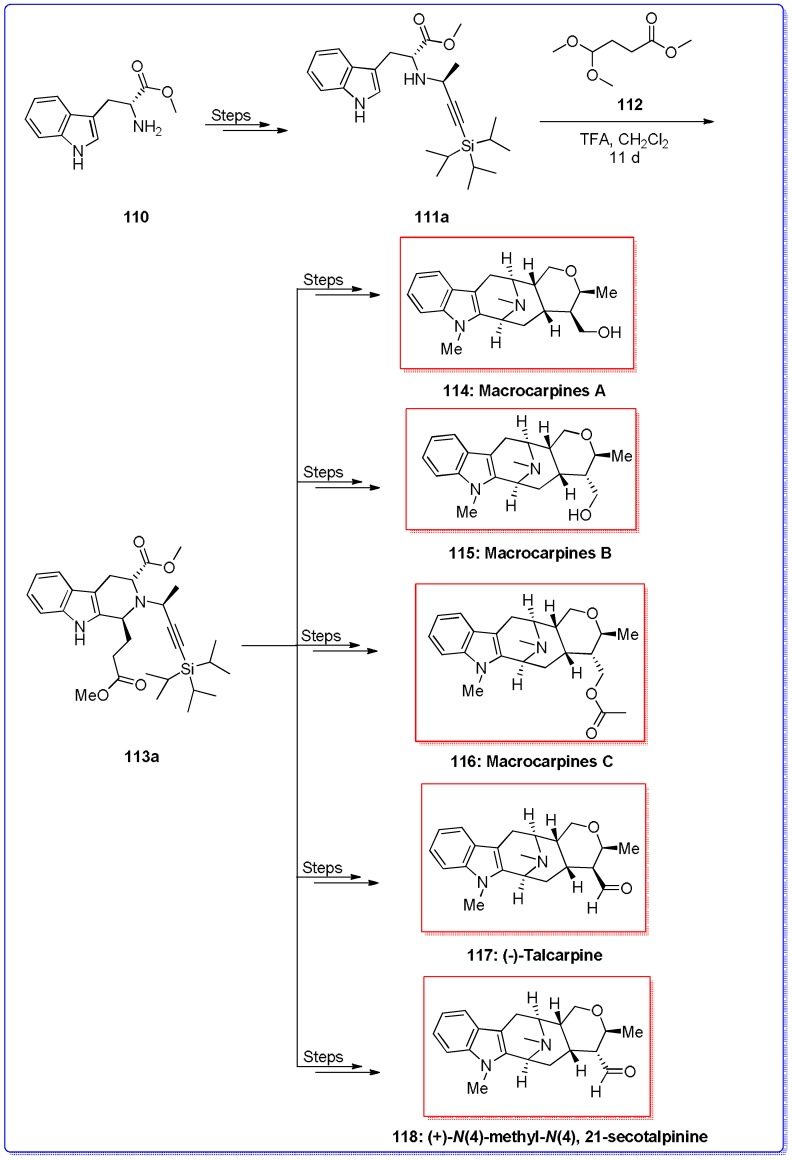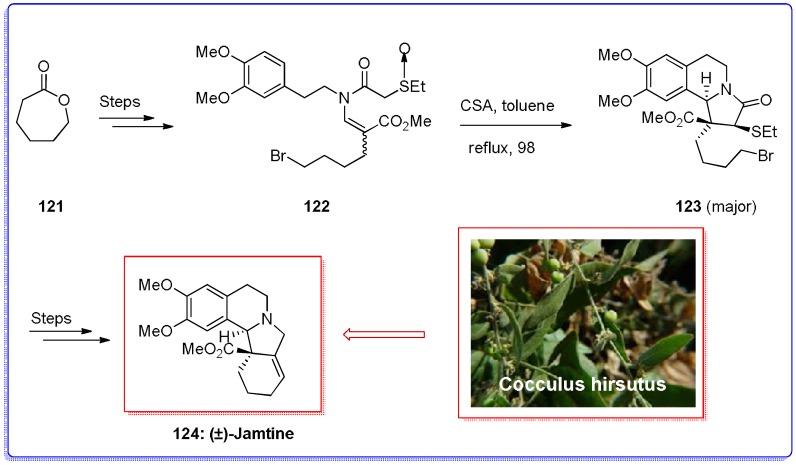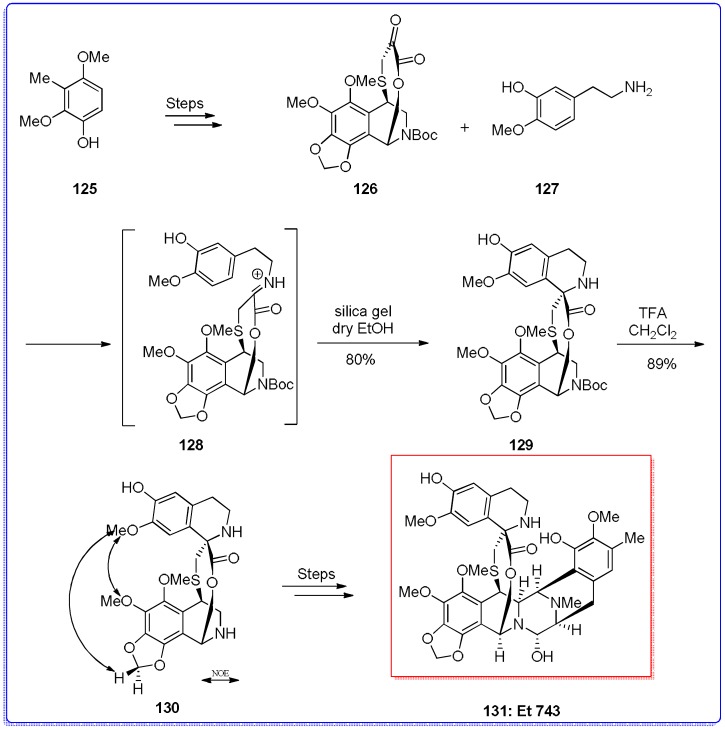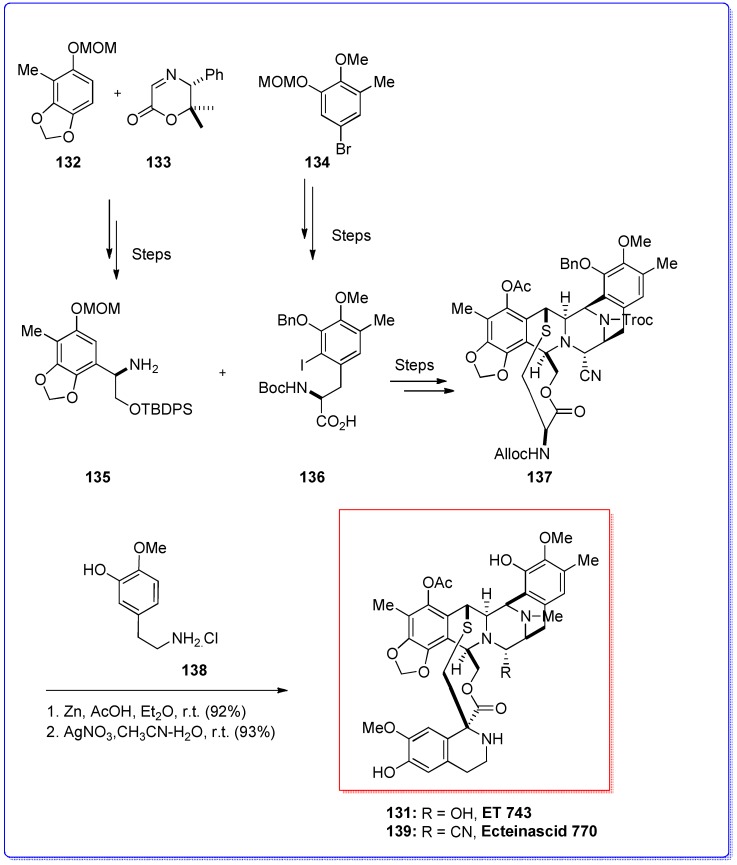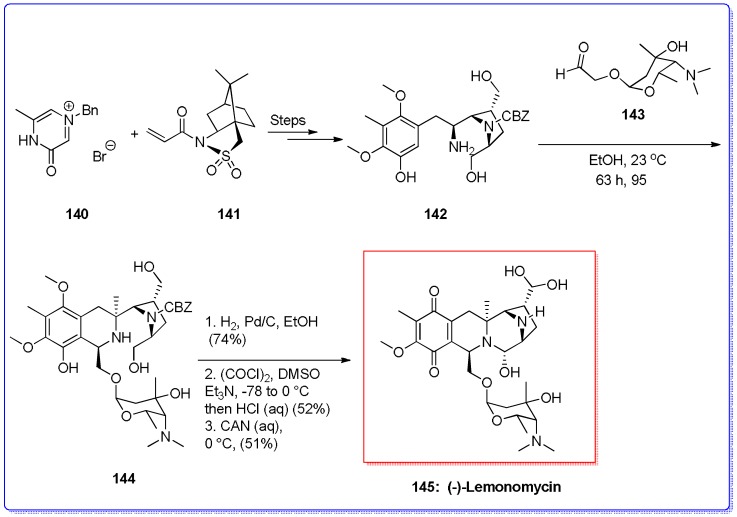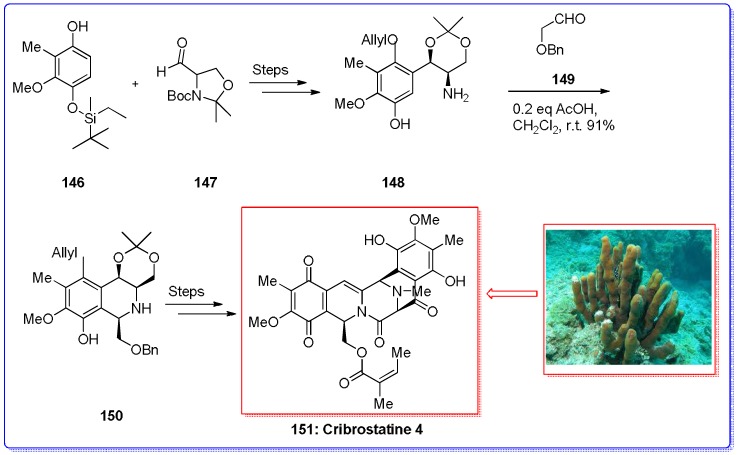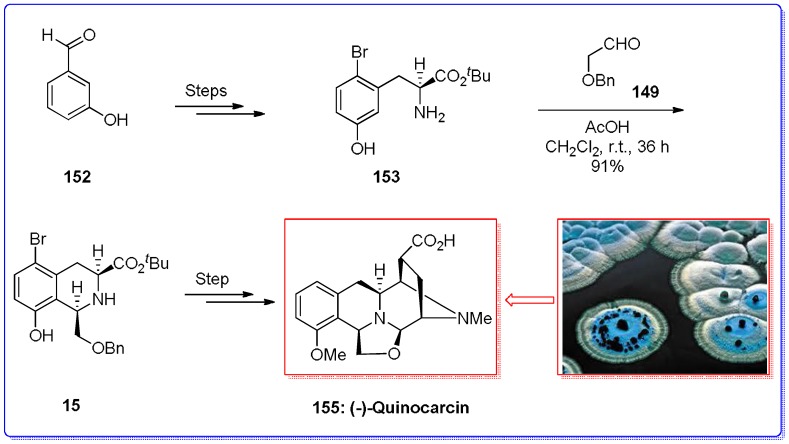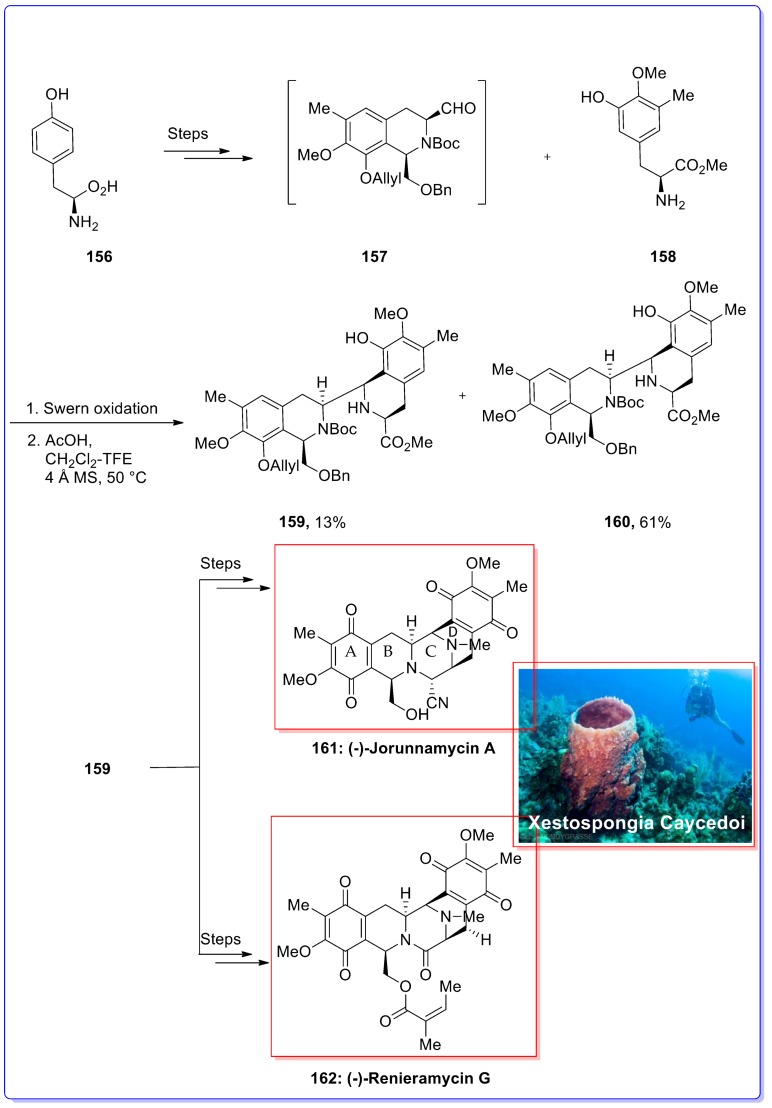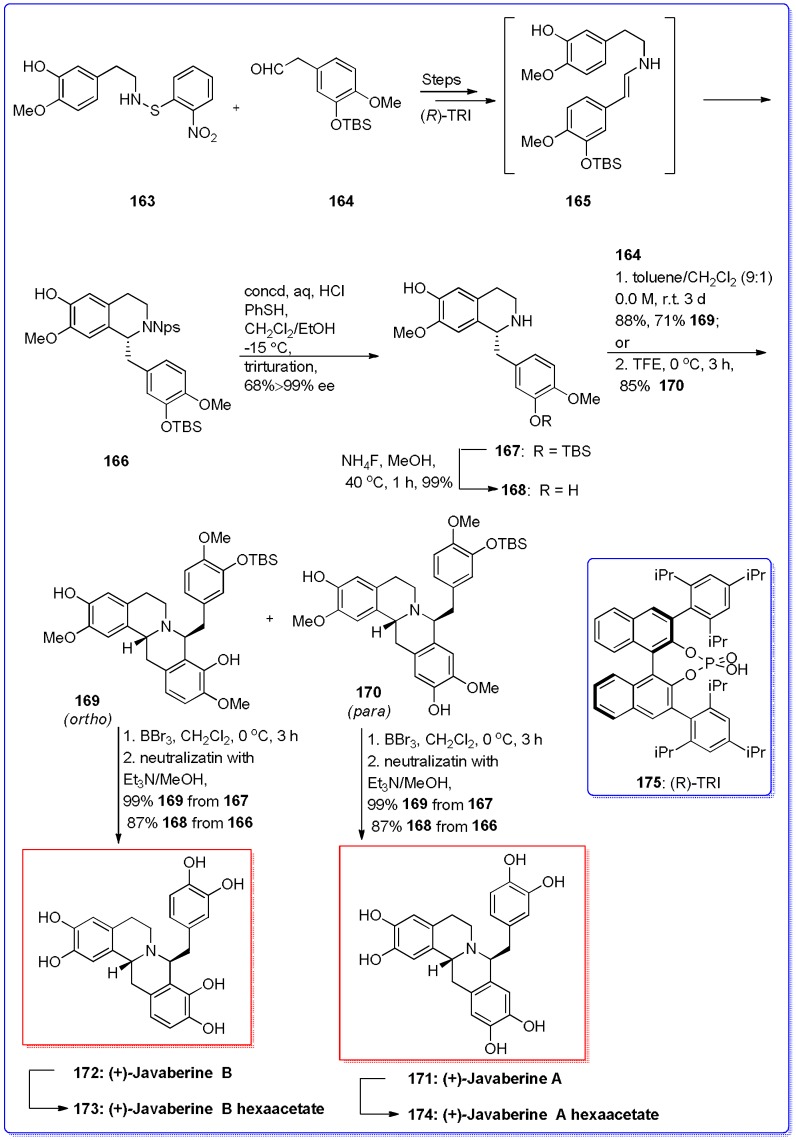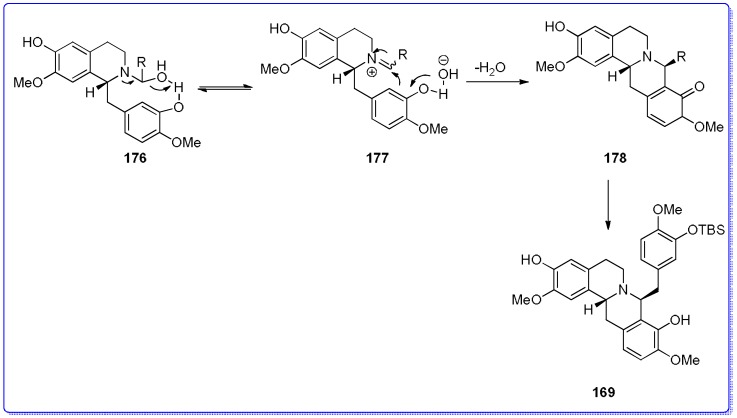Abstract
Tetrahydroisoquinolines are the framework of numerous natural products predominantly alkaloids, an important and one of the most wide spread families of naturally occurring compounds in the plant kingdom. Tetrahydroisoquinolines are commonly constructed through an old reaction, the so-called Pictet–Spengler Reaction (PSR). In this reaction, a β-aryl ethylamine undergoes an acid mediated condensation with a suitable aldehyde or ketone, followed by ring closure. In this review, we aim to highlight the applications of the asymmetric variant of this old name reaction in the total synthesis of natural products, chiefly, alkaloids, which exhibit significant biological properties.
Keywords: tetrahydroisoquinolines, asymmetric Pictet–Spengler reaction, total synthesis, natural products, biologically active compounds, β-aryl ethylamine
1. Introduction
Indole and isoquinoline derivatives, historically and currently are synthesized via an old reaction, the so-called Pictet–Spengler reaction (PSR). This old reaction nowadays has found a few new perspectives. It is currently and frequently used as a vital step in the total synthesis of natural products especially in those bearing indole and isoquinoline alkaloids as scaffolds in their complex structures [1,2,3].
The PSR was discovered more than a century ago, in 1911 by Ame Pictet and Theodor Spengler [4]. As illustrated in Scheme 1, they condensed phenethylamine 1 with methylal that is CH2(OMe)2 to obtain tetrahydroisoquinoline 2 [4]. Commonly, the PSR is a chemical reaction in which a β-arylethylamine such as tryptamine is cyclocondensed with an aldehyde or ketone under acidic and thermal conditions [5,6]. Some reactive substrates give acceptable yields even at physiological conditions [7]. Remarkably, the PSR can be considered as a special type of Mannich reaction.
Scheme 1.
The first example of the Pictet–Spengler Reaction (PSR), resulted in the synthesis of the tetrahydroisoquinoline (THIQ).
The PSR has been initially used for the synthesis of tetrahydroisoquinolines in the total synthesis of indole and isoquinoline alkaloids [3]. Since it was disclosed that isoquinoline alkaloids are generated in plants biosynthetically through the condensation of β-arylethyl amines with carbonyl compounds, this reaction has found useful practicality in the total synthesis of naturally occurring compounds bearing isoquinolines in their complex structures [8]. Typically, tryptamine and secologan are condensed to generate strictosidine, stereoselectively. As a matter of fact, tryptamine is the common precursor for the syntheses of all indole alkaloids [9,10].
The asymmetric type of this reaction was applied in various instances for stereospecific acceptance of this method and has played a key role in the total synthesis of various indole, oxindole, bisindole and in general, alkaloids [11,12,13,14,15,16,17,18]. In 2016, Dalpozzo reported an overview of the asymmetric PSR, in which the chirality was induced by optically pure amines or carbonyl compounds, obtained from natural sources or from asymmetric synthesis to assemble the reaction partners [19].
Alkaloids, are undoubtedly, the most important and widespread family of natural products in the kingdom of plants. A plethora of alkaloids has been extracted, isolated, screened and their biological properties have been evaluated, to mostly exhibit remarkable and various biological and pharmacological activities, thus, they have exceptionally attracted the attention of organic synthetic and bio-organic chemists. Alkaloids are natural products which include mostly one or more basic nitrogen atoms [20]. Moreover, this family includes some relevant neutral compounds and some of them can be even weakly acidic [21]. Alkaloids, in addition to carbon, hydrogen and nitrogen, may contain other elements such as oxygen, sulfur and even infrequently may have unusual elements such as, chlorine, bromine, and phosphorus.
Alkaloids are provided by a vast range of organisms including bacteria, fungi, plants and animals. They are typically purified from crude extracts of these organisms through acid–base extraction. Alkaloids exhibit a wide variety of biological activities for example quinine, the known anti-malaria agent, anticancer e.g. homoharringtonine [22], cholino mimetic such as galantamine [23], vasodilatory like vincamine, antiarrhythmic such as quinidine, analgesic such as the notorious morphine [24] antibacterial such as. chelerythrine [25], and antihyperglycemic like piperine [26]. Many of them have found found applications in traditional or modern medicinal chemistry or as starting points in novel drug discovery. Many others show also psychotropic (e.g. psilocin) and stimulant activities for example the notorious cocaine and morphine, the familiar caffeine, and the carcinogenic nicotine. Several of them are also used in entheogenic rituals or as medicines. Several of the alkaloids have been screened and evaluated as being toxic for instance atropine and tubocurarine [27]. Importantly, alkaloids are uniquely included in metabolic systems in humans and other animals. Most alkaloids have a bitter and unpleasant taste [28].
Among the accumulation of alkaloids, isoquinoline and β-carboline alkaloids have attracted much interest because of their extensive existence in plants and even in the animal protectorate. Furthermore, the above-mentioned alkaloids and particularly those including the isoquinoline scaffold commonly exhibit a comparative dominance of physiological properties [29]. Their biological activities, which range distinctly from extremely toxic, for example strychnine [30] to antihypertensive ajmalicine [31] and reserpine [32]. Moreover alkaloids show cytotoxic properties exhibited by vincoleucoblastine and vincristine are components applied in the cancer chemotherapy protocol [33,34]. Strikingly and fascinatingly, all these biologically active alkaloids are principally generated indoles from tryptamine attained from tryptophan and a terpenoid part that in turn is biosynthesized via the iridoid glucoside secologanin. Tryptamine and secologanin are condensed stereoselectively to create strictosidine, which is used as precursor for the total synthesis of virtually all alkaloids bearing the indole moiety in their structures [10,35].
The total synthesis of natural products including multiple generations of chiral centers remains attractive in both industrial research and development (R & D) as well as academic research [36,37,38]. In this line, predominantly, multi-component cascade, tandam, domino and sequential reactions, in the total synthesis of natural products and synthetic scaffolds within complex molecules, are involved [39,40,41,42]. Alkaloids constituting the indole moiety are a significant class of natural products. Particularly, the indolo[2,3-a]quinolizidine scaffold is a common frame work present in numerous biologically active significant products [43,44].
We are particularly interested in heterocyclic chemistry [45,46,47,48,49,50,51] and heterocyclic compounds exhibiting comparatively acceptable biological properties [51,52,53]. Recently, we have underscored the applications of several name reactions and stereoselective synthesis in the total synthesis of biologically active naturally occurring compounds [54,55,56,57,58,59]. In this report, we try to underline the most recent and current applications of another old but significant name reaction, PSR as a vital step in the total synthesis of biologically active natural products, specially, alkaloids.
2. Pictet–Spengler Reaction in the Total Synthesis of Natural Products
2.1. Indole Scaffold
Several alkaloids contain indole as a scaffold in their structure. In addition, numerous indole alkaloids involve isoprene groups and are therefore called terpene indole or secologanin tryptamine alkaloids. Notably, more than 4100 various alkaloids have been recognized thus, it is one of the largest groups in the plant kingdom [60]. Several of them contain important physiological properties and some of them have been applied in medicine. Remarkably, the amino acid tryptophan is the biochemical precursor of indole alkaloids [61].
(+)-Ajmaline 7 was extracted in 1931 from the roots of Rauwolfia serpentine [62] and was found to contain six rings and four heteroatoms, along with stereogenic centers. Significantly [62,63], it is a clinically important cardiovascular indole alkaloid [64,65,66] having historical prominence and is correlated to the sarpagine bases [67]. The most significant action of ajmaline is an anti-arrhythmic influence on the heart which is just less marked than that of the prescribed drug propranolol [66].
Furthermore, alkaloid G 8 was extracted from plant cell cultures of Rauwolfia serpentina Benth by Stöckigt and co-workers [68], which upon feeding tests with ajmaline is also structurally analogous to 7. Cook and co-workers in 1999 reported a common method (oxyanion-Cope strategy) for the formation of ajmaline indole alkaloid [69]. (+)-Ajmaline 7 and alkaloid G 8 as well as norsuaveoline 9 were provided from d-(+)-tryptophan in an enantiospecific approach through the enantioselective PSR and a stereo controlled oxyanion-Cope rearrangement as the main steps. With this route, total synthesis of natural products ajmaline 7, alkaloid G 8 and 9 were achieved starting from d-(+)-tryptophan 3. Then, d-(+)-tryptophan 3 was converted into the tryptophan methylester 4b that was transformed to the Nb-benzyltryptophan derivative on stirring tryptophan methylester 4b with benzaldehyde in methanol at ambient temperature, followed by reduction of the imine provided by using sodium borohydride as reductive agent. Next, HOAc was added to the reaction mixture to destroy any remaining NaBH4 and the solvent was evaporated under reduced pressure. In the following, methyl 4,4-dimethoxybutyrate, chloroform, and trifluoro acetic acid were added directly to the reaction vessel and the solution was refluxed to produce the trans diester 5b in excellent yield (overall yield >85%). The trans isomer 5b via epimerization and a Dieckmann cyclization produced the β-ketoester after that the solvent was removed under reduced pressure. Noticeably, HOAc and HCl were added cautiously to the reaction vessel and, on heating, ketone 6b was formed in more than 98% enantioselectivity (overall yield from 4 > 74%). The ketone 6a was also synthesized by a similar method. Significantly, five chemical conversions from tryptophan methylester 4 to the (−)-tetracyclic ketone 6 were performed in two reaction vessels. The usefulness of this enantiospecific two-pot sequence through the trans transfer of chirality in the enantioselective PSR is the key feature because these reactions can be accomplished on a multi-hundred gram-scale to give the (−)-tetracyclic ketone 6a or 6b, that can be used as an easily accessible initiating precursor for the construction of optically pure sarpagine/macroline/ajmaline alkaloids. Moreover, d-(+)-tryptophan and l-(−)-tryptophan are easily accessible from marketable sources allowing entry into both antipodes of the natural products for biological examination. Lastly, (+)-ajmaline 7 and alkaloid G 8 were synthesized in 93% and 92% yield, respectively. In addition, the total synthesis of norsuaeoline 9 was accomplished in 10 reaction vessels with an overall yield of 28%. Remarkably, for the formation of these indole alkaloids a stereospecific PSR/Dieckmann method was used to make the main intermediate, (−)-Nb-benzyl tetracyclic ketone 6a or 6b, which was transformed to (+)-ajmaline 7, alkaloid G 8 and norsuaveoline 9 (Scheme 2) [69].
Scheme 2.
Total synthesis of ajmaline 7, alkaloid G 8 and norsuaveoline 9.
During the last decades, numerous macroline/sarpagine correlated indole alkaloids were isolated from different species of Alstonia [67,70,71]. Interestingly, the macroline/sarpagine alkaloids originated as a result of folktales, demonstrating the medicinal activities of the plants from which these alkaloids were extracted [72,73]. A range of alkaloids from Alstonia angustifolia were demonstrated to contain antiprotozoal property against Plasmodium falciparum or Entamoeba histolytica in vitro [74], whereas other sarpagine alkaloids were known to include sedative, ganglionic blocking, antibacterial or hypoglycemic properties [70]. These alkaloids were examined for activity against HIV [75,76,77] and cancer [75]. Noticeably, talpinine 15 is a characteristic illustrative of a seven-membered sub group of talpinine-related alkaloids that show pharmacological properties [70]. Inappropriately, to date, none of these bases have been provided or examined in vivo in detail. Talcarpine 16 is also a related macroline/sarpagine indole alkaloid whose total synthesis has not been reported so far [67,71]. Furthermore, two closely related ring-A methoxylated derivatives of alstonerine [71] contain parts of the bisindoles macralstonine and alkaloid H [67]. Macralstonine and its derivatives, in fact, were known to show significant hypotensive and antiamoebic properties, respectively [78,79,80]. The correlated monomer anhydro macrosalhine-methine 18 results in them being part of the bisindole (−)-macrocarpamine.
The asymmetric total synthesis of talpinine 15 and talcarpine 16 was performed in 13 steps (11 reaction vessels) in 10% and 9.5% overall yields, respectively. Furthermore, this synthetic method was used for the synthesis of alstonerine 17 and anhydromacrosalhine methane 18 in 14 reaction steps (12% overall yield) and 12 steps (14% overall yield), respectively. d-(+)-Tryptophan 3 acted here both as the chiral auxiliary and the initiating precursor that provided a simple pathway [from l-(−)-tryptophan] to the antipodes of these alkaloids, if desired. The stereo specific transformation of 3 into 14a/b on a multi-hundred gram-scale occurred in only two reaction vessels.
Total synthesis of talpinine 15 was initiated from d-(+)-tryptophan 3. After several steps, compound 10 was formed. To introduce the corresponding stereocenter at the C1 position having similar chirality to that of the natural macroline/sarpagine/ajmaline alkaloids, Soerens and co-workers [81] and Sakai and co- workers [82] performed the Pictet–Spengler condensation between Na-H, Nb-benzyl tryptophan methylester 10 and α-ketoglutaric acid 11. This approach gave a mixture of ester acids (trans-12a/cis-12b) and δ-lactams (trans-13a/cis-13b) with satisfactory trans diastereoselectivity (Scheme 3) [83].
Scheme 3.
Total synthesis of natural products talpinine 15, talcarpine 16, alstonerine 17, and anhydro macrosalhine methine 18.
The sarpagine alkaloid (+)-vellosimine 21 was extracted from the tree Geissospermum Vellosii in 1958 by Rapoport and co-workers [84,85]. Amorphous extracts of this bark, found as paopereira, have long enjoyed a reputation as a febrifuge [86]. Also, in Brazilian folk medicine it was described to have curare-like properties [87]. Moreover, (+)-vellosimine was extracted from different species of Rauwolfia that are widely dispersed thought Asia and Africa [88,89,90,91]. These plants are broadly used in traditional Chinese medicine for the treatment of hypertension [89,92] neuralgia, and migraine [93].
The first stereospecific total synthesis of the Na-H functionalized indole alkaloid (+)-vellosimine 21 was performed by Cook and co-workers in 2000 from market purchasable d-(+)-tryptophan methylester 19 in seven reaction steps in 27% overall yield through the enantioselective PSR and a stereo controlled intramolecular Pd (enolate-catalyzed) coupling reaction as main steps [94].
Significantly, the chirality at C-3 and C-5 was developed by the enantioselective PSR and Dieckmann reaction in a two-pot approach [95]. Next, benzylation of the Nb-amino scaffold of d-tryptophan methyl ester 19 afforded Na-H,Nb-benzyl d-tryptophanmethyl ester, that was readily transformed to the trans diastereomer 20 with 100% diastereoselectivity based on the improved conditions of the PSR (83% yield). Upon several steps, the trans diester afforded the natural product vellosimine 21 (Scheme 4) [94].
Scheme 4.
Total synthesis of vellosimine 21.
The asymmetric synthesis of 7-methoxy-d-tryptophan was performed using a combination of the Larock hetero annulations method with a Schöllkopf-relied chiral auxiliary in satisfactory yield. Remarkably, this ester was used in the first total synthesis of (+)-12-methoxyaffinisine, (+)-12-methoxy-Na-methyl vellosimine, and (−)-fuchsiaefoline in a regiospecific, stereospecific approach in high overall yield. The enantioselective PSR and enolate-driven Pd-mediated cross coupling methods acted as the main steps. In this route, initially, 2-iodo-6-methoxyaniline 22 [96] and the propargyl-functionalized Schöllkopf chiral auxiliary 23 [97] reacted to provide Nb-benzylester 24, after several steps [98]. In the following, the Pictet–Spengler condensation of aldehyde and the Nb-benzylamine 24 occurred using HOAc in dichloromethane to provide a mixture (at C-1) of cis-26a and trans-26b diesters in approximately quantitative yield in a ratio of 1:2. Once trifluoro acetic acid/dichloromethane was used in this stage instead of acetic acid/dichloromethane, decomposition of a considerable amount of the 7-methoxytryptophan 24 was detected. Mechanistic studies on the carbocation-catalyzed cis/trans isomerization [99,100], showed that once the PSR was completed, five equivalents of trifluoroacetic acid had to be added to the reaction mixture to epimerize the cis diastereomer 26a into the corresponding trans diastereomer 26b. Finally, the formation of (+)-12-methoxy-Na-methyl-vellosimine 27, (+)-12-methoxy-affinisine 28, and (−)-fuchsiaefoline 29 was performed (from D-tryptophan) in 7,8, and 9 reaction steps, respectively. The enantioselective PSR and an enolate-driven Pd-catalyzed cross-coupling reaction are the two essential stages used to develop the correct stereochemistry in the senatorially occurring compounds (Scheme 5) [98].
Scheme 5.
Total synthesis of natural products (+)-12-methoxy-Na-methyl-vellosimine 27, (+)-12-methoxy-affinisine 28 and (−)-fuchsiaefoline 29.
A range of bisindole alkaloids extracted from Alstonia [70,101] species were exhibited to show anti-malarial properties [74] against a drug resistant (K-1) strain of Plasmodia falciparum comprising macrocarpamine, villalstonine, and macralstonine O-methylether [102,103]. Bisindoles have noteworthy importance since they show more significant biological properties than the monomeric parts that contain them [74,102,103], which is reminiscent of the significant anti-tumor properties of the Vinca alkaloids, vinblastine, and vincristine. The bio mimetic coupling reaction of macroline with the obligatory monomeric alkaloid to give the Alstonia bisindoles villalstonine [104,105] macralstonine [106] and alstonisidine [104,107] was initiated by LeQuesne. These alkaloids were synthesized from the distinctive attack of a monomeric part at C(9) of the sarpagine 33a-c ring system. The latter ring-A oxygenated indole derivatives are not that stable, therefore only trace amounts of the bisindoles (for example 35) [107,108] have been provided from plants.
The asymmetric stereospecific total synthesis of majvinine 33a, 10-methoxyaffinisine 33b, and Na-methylsarpagine 33c were developed by Cook and co-workers in 2002 [109]. In addition, this strategy led to the total synthesis of the Alstonia bisindole macralstonidine 35.
This approach is the initial stereospecific synthesis of ring-A alkoxylated indole alkaloids in the sarpagine series. This methodology is distinctive because the natural series (33a, 33b, 33c) can be synthesized from the inexpensive l-valine and the stereochemistry of the E-ethylidene function can be literally controlled by the enolate catalyzed Pd0 cross coupling route. The method to synthesize the bisindole 35 is doubly convergent because the similar key tereochemical methods (enantioselective PSR and enolate catalyzed Pd0 method) were used [110] to provide both monomeric parts that could be coupled through the pioneering work of LeQuesne and Garnick [107].
The synthesis started with the easily accessible 3-methyl-5-methoxy indole, which is synthesized [111] through the Japp Kingemann/Fischer indole method [112]. After several steps, Na-methyl-5-methoxy-d-tryptophanethylester 31 was formed. Favorably, the conversion of 31 into the corresponding trans diester 32 should have followed the well-documented trans transfer of chirality in the enantioselective PSR [99] in a direct technique; though, this was not the case. The presence of the 5-methoxy group in 31 assisted the PSR (with benzaldehyde); furthermore, this 5-methoxy indole system was not stable in trifluoro acetic acid/dichloromethane for prolonged periods of time. Noticeably, if amine 31 was transformed to the desired Nb-benzylimine with benzaldehyde/ethanol at ambient temperature [99], important quantities of the 1-phenyltetrahydro β-carbolines were provided [110]. Although, if the imine was provided at 0 °C, followed by reduction at −5 °C, merely the desired Nb-benzyl analogue was detected. Next, compound 31 was not stable in dichloromethane/trifluoro acetic acid for prolonged periods, and the PSR occurred with the aldehyde (instead of the acetal [99]) in acetic acid/dichloromethane. When the cyclization was accomplished to give a mixture of trans and cis diastereomers, a few drops of trifluoro acetic acid were added [99,110] to assist epimerization (at C-1)of the cis isomer into the corresponding trans diastereomer (>98% de).
After several reaction sequence involving the Wittig/hydrolysis/epimerization reaction, (+)-majvinine 33a was obtained. (+)-Majvinine 33a (obtained from tryptophanethyl ester 31) was synthesized in gram quantities (8 steps) in 28% overall yield and acted as the key, stable intermediate for the formation of other naturally occurring compounds in this sequence (Scheme 6) [109].
Scheme 6.
Total synthesis of natural products (+)-majvinine 33a, (+)-10-methoxyaffinicine, and (+)-Na-methylsarpagine 33c.
Besides, the alkaloid (+)-majvinine 33a has been used for the total synthesis of (+)-Na-methyl sarpagine 33c. Remarkably, (+)-macroline can be reacted with Na-methylsarpagine 33c based on the bio mimetic conditions of Garnick [107] to give 35; therefore, this provides the initial total synthesis of a bisindole alkaloid in the Alstonia groups. More significantly, the trans transfer of chirality using the Schöllkopf chiral auxiliary once coupled with the trans transfer that occurs in the enantioselective PSR necessarily defines that natural ring-A alkoxylated indoles can be synthesized from inexpensive l-valine whereas d-valine is vital for the antipodal series (Scheme 7) [109].
Scheme 7.
Total synthesis of bisindole macralstonidine 35 using PSR as the key step.
Strychnofoline belongs to a family of naturally occurring compounds, extracted from the leaves of Strychnos usambarensis [113], that shows antimitotic property against cultures of mouse melanoma and Ehrlich tumor cells with strychnofoline exhibiting the uppermost properties [114]. An important structural aspect of these and correlated spirotryprostatin alkaloids [115] is the existence of the aspiro[pyrrolidin-3,3′-oxindole] core.
Carreira and co-workers in 2002 demonstrated a significant synthesis of the antitumor alkaloid (±)-strychnofoline. A key feature of the development of the extremely convergent method described, is the coupling reaction of acyclicimine with spiro[cyclopropan-1,3′-oxindole], which occurs in a highly diastereoselective manner [116].
In this route, for the synthesis of (±)-strychnofoline, the reaction of 36 and imine 37 occurred and after several steps afforded aldehyde 38. With this pathway, PSR [117] between aldehyde 38 and N-methyl-tryptamine 39 using acetic acid in toluene at 80 °C gave a diastereomeric mixture of products 40a and corresponding 40b nonselectively (1.5:1) in a combined yield of 64% [118,119]. Remarkably, deprotection of 40b gave (±)-strychnofoline 41 in 82% yield (Scheme 8) [116].
Scheme 8.
Total synthesis of strychnofoline 41.
Eudistomins, extracted by Rinehart and co-workers in 1984 [120,121,122] from a Caribbean tunicate (Eudistoma oliVaceum), are members of the tetrahydro-β-carboline group of marine alkaloids. Among eudistomins, eudistomin C, E, K, L, and F, containing the hither to unknown oxathiazepine ring, demonstrated highly significant antiviral properties against both RNA and DNA viruses as well as antimicrobial and antitumor properties [122,123].
Fukuyama and co-workers in 2005 demonstrated the stereo controlled total synthesis of (−)-eudistomin C 46 which relied on the development of the Brønsted acid-mediated diastereoselective PSR and the unprecedented production of an unusual oxathiazepine ring. The 18-step reaction with an overall yield of 7.7% permitted the gram-scale formation of eudistomin C to be performed as well as diverse derivatives.
In this method, for the synthesis of (−)-eudistomin C 46, at first, the synthesis of the indole part [124] initiated from nitroaniline 42, was easily synthesized from m-anisidine in four stags [124]. The diastereoselective production of tetrahydro-β-carboline could be achieved by the PSR [125] of the tryptamine derivative and Garner aldehyde 43 [126,127]. The researchers focused their attention on the critical PSR of Garner aldehyde 43. Meanwhile, a first effort using a model substrate of 44 lacking the bromo and methoxy substituents afforded the unexpected diastereomer as the major product (3:1) under conventional reaction conditions (trifluoro acetic acid in dichloromethane, −78 °C), They examined a wide range of acid catalysts and solvents. Astonishingly, they realized by using a catalytic quantity of dichloro-acetic acid or chloro-acetic acid in toluene the reaction proceeded smoothly at 0 °C to give the corresponding diastereomer 45 with excellent selectivity (11:1). After several steps, compound 45 was converted into the natural product (−)-eudistomin C 46 (Scheme 9) [128].
Scheme 9.
Total synthesis of eudistomins C 46.
Mitragynine 52 was extracted from Mitragyne speciosa Korth [129,130] and used as a substitute for opioids of painin in Thailand. In 1965, the X-ray crystal structure of the hydroiodide salt of mitragynine was obtained for its certain structural elucidation [131]. However, mitragynine was the main alkaloid from the extract of Mitragyne speciosa, a more careful examination demonstrated that a more significant alkaloid, was existent in the mature leaves of M. speciosa (Thailand). In addition, this hydroxyl derivative could be provided from the oxidation reaction of mitragynine with iodobenzene di-acetate [132]. Fascinatingly, the methoxyl functional substituent was known, being required for its analgesic property [133].
The alkaloid 9-methoxy-geissoschizol [132] was extracted from the bark of Strychnos guianensis [134], that is known in the basin of the upper and middle Orinoco rivers and throughout the Amazon basin. The crude extracts from the root and stem bark demonstrated a muscle relaxant property [135]. The related 9-methoxy-Nb-methylgeissoschizol 54 that is a quaternary indole alkaloid was recognized later [136].
An asymmetric strategy for the formation of 4-methoxy tryptophan was accomplished through a regiospecific Larock hetero annulation and used for the initial total synthesis of 9-methoxy geissoschizol 53, 9-methoxy-Nb-methylgeissoschizol 54, and the total synthesis of mitragynine 52, starting from 4-methoxy-d-tryptophan 47. The enantioselective PSR and Ni(COD)2-catalyzed cyclization reaction acted as main stages to setup the stereochemistry at C(3) and C(15) in these indole alkaloids.
Total synthesis of natural products 52, 53, and 54 were initiated from 4-methoxytryptophan which after several steps afforded the secondary amine 48. The corresponding stereocenter at C-3 was accomplished through the enantioselective PSR [4] of the secondary amine 48 and the aldehyde [137] 49 to supply the tetrahydro-β-carboline 50. Next, this diester 50 was transformed into the corresponding α,β-unsaturated ester 51 in 64% overall yield through a number of normal conversions comprising elimination of one equiv of thiophenol from tetrahydro-β-carboline 50, followed by an oxidation reaction with meta-chloroperoxy benzoic acid and a sulfoxide removal sequence [137,138]. Next, after several steps, 9-methoxygeissoschizol 53 was synthesized in 90% yield. In addition, 9-methoxy-Nb-methylgeissoschizol 54 was formed through the Nb-methylation of 53 with methyl iodide followed by exchange of the iodide to the chloride by silver chloride. The 13C-NMR data of synthetic (+)-54 was in agreement with those determined for the naturally occurring compound [134,136]. Besides this, through another approach from α,β-unsaturated ester 51, after several steps, mitragynine 52 was synthesized (Scheme 10) [139].
Scheme 10.
Total synthesis of mitragyine 52, 9-methoxygeissoschizol 53, and 9-Methoxy-Nb-methylgeissoschizol 54.
Yohimbine 59, a significant member of the monoterpenoid indole alkaloids, belongs to a large group of naturally occurring compounds which shows synthetically challenging structures showing different biological properties [140,141]. The total synthesis of (+)-yohimbine was accomplished in 11 steps and 14% overall yield in 2008 by Jacobsen and co-workers [142]. The absolute configuration was developed by an extremely asymmetric thiourea-mediated acyl-PSR, and the remaining four stereocenters were set concurrently in a substrate-controlled intramolecular Diels-Alder reaction.
In this pathway, total synthesis of (+)-yohimbine was begun with the formation of N-acetyltetrahydro-β-carboline 58 through the acyl-PSR [143]. Condensation of tryptamine 55 with aldehyde 56 [144], and the resultant imine with acetylchloride and 2,6-lutidine using thiourea catalyst 57 (10 mol%) gave 58 in 81% yield and 94% ee on a gram scale. After several steps, (+)-yohimbine 59 was provided in 14% overall yield (Scheme 11) [142].
Scheme 11.
Total synthesis of yohimbine 59.
The deplancheine-typetetracyclic indole alkaloid arboricine 65, extracted from the leaves of Kopsiaarborea by Kam and co-workers in 2009, exhibited an adequate ability to reverse multi-drug resistance in vincristine-resistant KB(VJ300) cells [145].
Hiemstra and co-workers in 2009 reported, a significant six-step synthesis initiated from tryptamine affording the tetracyclic-carboline arboricine in 33% overall yield through an asymmetric organocatalytic PSR and intramolecular palladium(0)-mediated vinyliodide-enolate coupling as the main stages. Another three-step pathway initiated from tryptamine afforded arboricine in an overall yield of 35% but lower ee.
The synthesis initiated with the tryptamine [146], generated in one-step through alkylation reaction of tryptamine and Z-2-iodo-2-butene-1-olmesylate in 84% yield (not shown in the Scheme) [146] PS condensation reaction of 60 with aldehyde 61a catalyzed by (R)-3,3′-triphenylsilyl-binolphosphoricacid 63a ((R)-binol-PA, 5 mol%) afforded β-carboline (S)-62a together with aminal 64 in 55% yield and a 75/25 ratio, respectively, and an unacceptable 38% ee for both (S)-62a and 64, as identified by chiral HPLC. Happily, masking of ketone 61a as the dioxolane 61b not only evaded aminal construction therefore solely affording (S)-62b in 81% yield but also increased the ee to 78%. It is significant that installing the acetal masking substituent, that is quite remote from the iminium intermediate, increases both the enantioselectivity and the rate of the PSR using lower catalyst loadings down to 1%. The mildness of the method is underscored by the fact that the dioxolane-protected ketone stayed unaffected. Clearly, (R)-62b has been produced initiated from (S)-binol-PA. Remarkably, the best ee was obtained using the sterically somewhat more demanding catalyst (R)-H8-binol-PA 63b, which afforded (S)-62b in 86% yield and 89% ee. Scaling up the reaction to 5 mmol only required 1 mol% of catalyst 63a giving (S)-62b in an extracted yield of 92% and 78% ee.
To circumvent the probable racemization through acid-mediated scission of the bond between the enantioselective carbon atom and Nb [147] during the hydrolysis of the acetal scaffold, a Boc-masking substituent was achieved on the indole. Reaction of 62b with Boc2O and DMAP followed using diluted hydrochloric acid in acetone afforded the corresponding ketone which in two steps gave (−)-arboricine 65 in 81%. Synthetic arboricine was enantio pure by HPLC (method A).
In another pathway, dissolving 62b in dilute hydrochloric acid in acetone afforded quantitatively a mixture of 62a together with aminal 64 in a 2/3 ratio, respectively. Gratifyingly, based on the slightly basic conditions of the final palladium(0)-mediated cyclization, an equilibrium between 62a and 64 existed permitted a significant and diastereoselective transformation to arboricine 65 in a yield of 78%, although ee dropped from 86% to 65% (method B) (Scheme 12 and Scheme 13) [148].
Scheme 12.
PSR in the presence of 63 as a catalyst.
Scheme 13.
Total synthesis of tetracyclicindole alkaloid (−)-arboricine 65.
Henrycinols A and B, two indole alkaloids, extracted from Melodinus henryi CRAIB of Apocynaceae genus by Zhang and co-workers [149]. These alkaloids belong to the class of 1,2,3,4-tetrahydro-β-carbolines, a structural scaffold, that is, abundant in a range of indole alkaloids [150]. Structurally henrycinols A and B differ from simple 1,2,3,4-tetrahydro-β-carbolines with the presence of two hydroxyl substituent on the D ring of the alkaloid. The total synthesis of indole alkaloids henrycinol A and B were performed initiating from l-tryptophan methyl ester. The main step is a stereochemically flexible PSR provided by the presence or absence of an N-allyl substituent in the tryptophan precursor. The natural products henrycinol A and B were obtained in satisfactory overall yield in eight and nine steps, respectively. Therefore, the synthetic sequence starting with the PSR of the desired aldehyde [151,152] obtained from (−)-2,3-O-isopropylidene-d-threitol 66 with l-tryptophan methylester 67 gave a separable mixture of 1,3-cistetrahydro-β-carboline 69α as the main product in 50% yield and 1,3-trans tetrahydro-β-carboline 69β in 18% yield [149].
Since the naturally occurring compound included the trans tetrahydro-β-carboline isomer, it was posed with the challenge of procuring the needed 1,3-trans-1,2,3,4-tetrahydro-β-carboline in excellent yield in the PSR. Pioneering work by Cook’s group [153,154,155] established the transformation of 1,3-cis to 1,3-trans products in the PSR of tryptophan methylester with benzaldehyde. They detected that the reaction of N-functionalized tryptophan esters rendered the 1,3-trans-1,2,3,4-tetrahydro-β-carbolines using non-acidic conditions, whereas simple tryptophan esters without substitution gave the 1,3-cis carbolines under acidic conditions. Considering these results, it was reasoned that the PSR of N-allyl-l-tryptophan methylester 68 with the corresponding aldehyde should provide the 1,3-trans-1,2,3,4-tetrahydro-β-carboline 70b. Actually, this was known to be the case, and the reaction between N-allyl-l-tryptophan methylester 68 and the corresponding aldehyde obtained from (−)-2,3-O-isopropylidene-d-threitol 66), gave the 1,3-trans-1,2,3,4-tetrahydro-β-carboline 70β as the main product in 79% yield. After several steps, the 1,3-trans-1,2,3,4-tetrahydro-β-carboline 70β gave henrycinol A 71 in 78% yield.
The stereochemistry of the freshly provided stereogenic center in the PSR and the structure of the natural product was definitely confirmed by X-ray crystal structure analysis of henrycinol A 71. Furthermore, reaction between henrycinol A 71 and isobutyrylchloride using Bu2SnO and CsF [156,157] gave henrycinol B 72 in 24% yield, the regioisomer 73 in 10% yield and the recovered initiating compound henrycinol A 71 in 47% yield. Significantly, stereoselective first total synthesis of the indole alkaloids henrycinol A 71 and B 72 were performed from N-allyl-l-tryptophan methylester 68 and (−),2,3-O-isopropylidene-d-threitolin 34% and 8% overall yields, respectively in eight and nine linear stages. The key conversion was the trans-selective construction of 1,3-dialkyl-1,2,3,4-tetrahydro-β-carboline in the Pictet–Spengler cyclisation (Scheme 14) [158].
Scheme 14.
Total synthesis of natural products henrycinols A 71 and B 72.
The remarkable pharmacological activities in cerebral circulation and neuronal homeostasis of eburnamine-vincamine indole-type alkaloids, including vincamine 79a, eburnamine 79b, and vinpocetine 79c [159,160], make them striking products for total synthesis [161]. Until 2014, the most usual method to develop the [ABCD]-ring system of these compounds was to begin from an indole subunit to make the final E-ring [162,163,164]. Significant production of a cis-[ABCD]-ring intermediate, the katsubenitrile 78, is the main stage for synthesis of 79. The katsubenitrile 78 is a building block in the three usual synthetic pathways, that all apply various methods, for the production of the cis-stereocenters of 79. An efficient synthesis of the katsubenitrile is accomplished through a significant diastereoselective PSR of 3-ethyl-2-hydroxy-1-[2-(1H-indol-3-yl)ethyl]-6-oxopiperidine-3-carbonitrile to form the cis-[CD] rings in 1-ethyl-4-oxo-1,2,3,4,6,7,12,12β- octahydroindolo[2,3-α]quinolizine-1-carbonitrile as the main stages.
In this approach, total synthesis of katsubenitrile 78 was initiated from the readily available ethyl-2-cyanobutanoate [165] and tert-butylacrylate which after several steps gave the N,O-hemiacetal 76 as an inseparable 3:2 mixture of epimers. Next, the PSR of 76 was explored to construct the tetracyclic compound 77. Reaction of 76 with trifluoro acetic acid (TFA) in CH2Cl2 at −55 °C afforded no reaction, while, elevating the reaction temperature to 20 °C afforded the corresponding compound 77 as a 2:1 mixture of epimers. A short investigating action of different acids occurred, and it was recommended that chlorotrimethylsilane was the most effective for control over the diastereoselectivity at ambient temperature, giving 77 in a 96% yield with a diastereomeric ratio of 3.5:1. These epimers of 77 could be easily separated by chromatography. In addition, the extremely crystalline nature of the epimers permitted X-ray crystallographic analysis, thus confirming the stereochemical assignment. Upon two steps, katsubenitrile 78, a main synthetic intermediate for eburnamine-vincamine alkaloids, was provided in satisfactory yields (2:68%, 12-epi-2:65%) (Scheme 15) [166].
Scheme 15.
Total synthesis of katusbenitrile 78 using PSR as key step.
Lindera aggregate is extensively dispersed in China and widely employed in traditional Chinese medicine for the treatment of a number of physiological symptoms [167]. Pharmacological investigating actions on L. aggregata (Lauraceae) demonstrated diverse important bioactivities, comprising super oxide anion radicals avenging, and protection against post-ischemic myocardial dysfunction, as well as slowing down the progression of diabetic nephropathy in db/db mice [168,169,170]. Linderaggrine A 85 is a β-carboline alkaloid, from the roots of L. aggregata. β-Carboline alkaloids are a predominant class of biologically active naturally occurring compounds having an extensive range of pharmacological and structural diversity [171,172,173]. The successful construction of linderaggrine A 85 and 89 gave unambiguous evidence for the determination of the naturally extracted product. Wu and co-workers in 2014 designed synthesis of 1-functionalized β-carbolines, using a single-step PSR [174]. The synthetic approaches employed to provide linderaggrine A 85 and its isomer by single-step PSR of 5-methoxytryptamine or 6-methoxy tryptamine with p-methoxy phenyl glyoxal were demonstrated. The precursors 5-methoxy tryptamine or 6-methoxy tryptamine and p-methoxy phenyl glyoxal were reacted by PSR to result in a mixture of dihydro-β-carbolines 83 or 87 and β-carbolines 84 or 88. To increase the yield of this conversion, MnO assisted dehydrogenation provided the aromatic β-carbolines 84 or 88 in satisfactory yields (38% and 40%, respectively). The deprotection of the methyl substituent in both phenyl rings was examined by either HCl or AlCl3; though, only one of the methyl substituents could be disintegrated. Thus, the hydrobromic acid–acetic acid pair was applied to deprotect the two methyl substituents in one step with satisfactory yields (30% for 85 and 40% for 89, respectively). But, there is a slight difference between the synthetic products of 85 and 89. In the deprotection reaction of 88 to 89, 8-brominated product 90 was afforded because of the bromine provided from the decomposition of HBr. In contrast, demethylation of β-carboline 84 merely afforded the mono-demethylation product 85 and the desired di-demethylation product 86. The bio-activity consequences demonstrated the application of the roots of L. aggregata as herbal medicines in the reaction of inflammatory diseases, and linderaggrine A 85 may be potential in examining novel anti-inflammatory lead drugs (Scheme 16 and Scheme 17) [175].
Scheme 16.
Synthesis of linderaggrine A 85 and mono-demethylation product 86.
Scheme 17.
Synthesis of product 89, the isomer of linderaggrine A, and 8-brominated product 90.
Peganumine A 94, a dimerictetrahydro-β-carboline alkaloid, was extracted by Li, Hua and co-workers in 2014 from the seeds of Peganum harmala L [176]. Its octacyclic structure having a distinctive 3,9-diazatetracyclo-[6.5.2.00] [176,177,178,179] pentadec-2-one moiety has been unprecedented. It demonstrated importantly the toxic property against MCF-7, PC-3, Hep G2 cells and selective influence on HL-60 cells. A gram-scale asymmetric total synthesis of (+)-peganumine A was achieved in seven steps from market purchasable 6-methoxytryptamine. Key stages comprised a Liebes kind-Srogl cross coupling; a one-pot production of the tetracyclic scaffold from an ω-isocyano-γ-oxo-aldehyde through a sequence of an unprecedented carbon–carbon bond providing lactamization and trans annular condensation reaction; as well as a one-pot organo-catalytic method merging two a chiral building blocks into an octacyclic structure through a sequence of asymmetric PSR and by a trans annular cyclization reaction. This last reaction generated two spiro cycle derivatives and α-2,7-diazabicyclo[2.2.1]heptan-3-one part along with excellent control of both the absolute and relative stereochemistry of the two freshly generated quaternary stereocenters. Generally, (+)-peganumine A 95 was formed in seven steps with 33% overall yield (er 96/4) from the market purchasable 6-methoxytryptamine; the application of this synthetic method being accepted. In the following, the conditions to achieve a catalytic enantioselective synthesis of (+)-peganumine A were examined. The reaction of 91 and 92a using chiral phosphoric acid (TRIP) indeed gave 9′-demethoxy-peganumine A 94, although with poor yield (7%) and ee (er 64.5/35.5) [180]. Employing Jacobsen’s chiral thio urea catalyst (S)-93 was known to be more satisfactory [181]. Then, trifluoro acetic acid was added and the reaction mixture was refluxed for an additional two days to give (+)-9′-demethoxy-peganumine A 94 in 67% yield with er of 96/4. Applying PhCOOH as co-catalyst was of greatest significance for the enantioselectivity of the reaction since employing acetic acid in place of PhCOOH under otherwise similar conditions afforded compound 94 (75% yield) with significantly decreased ee (er 72/28). Condensation reaction of 91 with 92b gave (+)-peganumine A 95 (69%, er 96/4) in which the spectroscopic data were identical in all respects to those reported for the naturally occurring compound. As a result, the natural enantiomer was generated using (S)-93 as catalyst (Scheme 18) [182].
Scheme 18.
Thiourea-catalyzed enantioselective synthesis of (+)–peganumine A 95 by PSR as the key step.
In this route, total synthesis of (+)-peganumine A 95 began with 6-methoxytryptamine. The condensation reaction of amine 91 with α-ketoamide 92b gave imine 96, that underwent the asymmetric aza-Friedel-Crafts addition under the effect of the thiourea (S)-93 and PhCOOH to give the enantio enriched 97. After addition of a catalytic quantity of strong acid (trifluoro acetic acid), enamine-imine tautomerization occurred to form 98, that, after stereo specific trans annular addition of the secondary amine to iminium, provided octacycle 99. Elimination of N-Boc provided the natural product 95. Two quaternary stereocenters were made from two a chiral building blocks with excellent control of both de and ees (Scheme 19) [182].
Scheme 19.
Total synthesis of (+)-peganumine A 95.
The genus Kopsia, that belongs to the family Apocynaceae, is a rich source of mono terpenoid indole alkaloids containing extensive series of biological properties and structural diversity [183]. Takayama completed the structure clarification of different unique monoterpenoid indole alkaloids from Kopsia arborea, native to the Yunnan Province in China, [184,185] including an intriguing significant alkaloid named kopsiyunnanine K 104, that has an unprecedented azepine-fused tetrahydro-β-carboline ring moiety. A monoterpenoid indole alkaloid, kopsiyunnanine K 104, was extracted from Kopsia arborea. Its fascinating rearranged structure and absolute configuration, inferred from spectral data, and the probable biosynthetic route were identified on the basis of a 13-step enantioselective total synthesis.
Takayama and co-workers in 2016 reported the enantioselective total synthesis of kopsiyunnanine K 104 through an enantioselective Ireland–Claisen rearrangement and an intramolecular diastereoselective PSR, and exhibited its significant rearranged framework and absolute configuration. Total synthesis of kopsiyunnanine K 104, was initiated from market purchasable valerolactone 100, and after several steps comprising oxidation, Mitsonubu reaction, ozonolysis, and alkylation afforded aldehyde 103. Next, deprotection of the Ns group on the Nb position in 103 followed through intramolecular diastereoselective PSR of the obtained amine using trifluoroacetic acid (TFA) afforded kopsiyunnanine K 104 as a single diastereomer in a measurable yield. Recrystallization of the product gave optically pure 104. Noticeably, the structure and the 16R, 20R configuration of synthetic 104 were confirmed by X-ray crystallographic analysis (Scheme 20) [186].
Scheme 20.
Total synthesis of kopsiyunnanine K 104.
Spirooxindole alkaloids are interesting and challenging synthetic products, that have extremely complicated building blocks combined with favorable properties in numerous therapeutic areas [187,188]. Illustrative spirooxindole alkaloids contain trychnofoline 109, spirotry prostatins [115], palmirine [189], citrinadins [190], gelsemine [191], and cyclopiamines [192]. Amongst these attractive molecules, 109 seems to be a significant target for chemical synthesis and biological examination. It was extracted from the leaves of Strychnos usambarensis by Angenot and co-workers in 1978, and exhibited extremely promising antimitotic property against cultures of Ehrlich tumor cells and mouse melanoma. A striking synthesis of (±)-109 was shown by the Carreira group, in 2002, utilizing an elegant, extremely diastereoselective cyclopropane ring expansion method [116]. The five stereocentres and the unique spiro[pyrrolidin-3,3′-oxindole]scaffold show a substantial challenge for its synthesis.
Strychnofoline is a Strychnos alkaloid that has a significant spirooxindole framework and has a significant anticancer property. Xu and co-workers in 2018, for the first time, demonstrated the asymmetric synthesis of strychnofoline proceeding in only nine steps from market purchasable 6-methoxytryptamine.This method is highlighted by a one-pot, catalytic enantioselective production of the quinolizidine intermediate 108. The efficacy of the synthesis derives from the use of two sequential conversion stages in the catalytic enantioselective production of the spiro[pyrrolidine-3,3′-oxindole] scaffold in a simple method. Remarkably, the β-carboline framework could be generated through a late stage PSR. This pathway was performed through sequential acylation/enantioselective Michael addition/PSR/oxidative rearrangement.
Total synthesis of strychnofoline was initiated from market purchasable 6-methoxytryptamine 91. By sequentially adding 91; diketene 105, acrolein derivative 106; organocatalyst 107 (Hayashi-Jorgensen catalyst); and acyl chloride to the reaction mixture, they were able to obtain the quinolizidine derivative 108 in satisfactory yield with high ee (67% yield, ee >99%). After several steps, total synthesis of the anti-tumor alkaloids trychnofoline 109 was completed and the synthesized material, showed equal spectroscopic and analytical properties to that demonstrated for the naturally occurring compound [113,116]. A useful construction of 109 will be of great assistance in addressing its therapeutic promise (Scheme 21) [193].
Scheme 21.
Total synthesis of strychnofoline 109.
The C-19 methyl functionalized macroline/sarpagine and ajmaline alkaloids are an emerging group of biosynthetically related indole alkaloids, some of which have historical importance [194], and were principally extracted from different medicinal plants of the Apocynaceae group. Most of these alkaloids were not examined for their biological property, probably, because of the paucity of extracted material. Macrocarpines B were extracted from the stem bark of Alstonia macrophylla by Kam [195]. Talcarpine 117, extracted from Alstonia macrophylla and Pleiocarpa talbotii, showed antimalarial properties [71]. N(4)-Methyl-N(4), 21-secotalpi-nine 118, extracted from Pleiocarpa talbotii, and Alstonia angustifolia, exhibited remarkable anti-leishmanial properties [195,196,197].
The majority of these alkaloids have the β-methyl configuration at C-19, a few contain the α C-19 methyl function (for example dihydroperaksine 119, also found as dihydrovomifoline and deoxyperaksine) [198]. All of these alkaloids contain either a Na-methyl or Na-hydrogen functionalized indole nitrogen atom. Also, the Nb-nitrogen atom differs in the pattern of substitution. Furthermore, all of these alkaloids include a 6 or 7 quaternary center showing different substitution patterns and configurations that render the synthesis of these alkaloids of interest.
Extension of the enantioselective PSR to bulkier Nb-alkylated tryptophan led to an increased stereospecific admittance to the key bi-cycle [3.3.1] nonane unit of bioactive C-19 methyl functionalized sarpagine/macroline/ajmaline indole alkaloids having high diastereoselectivity through internal enantioselective induction. Full stereo control of the C-19 methyl function in either the α-or β-configuration has been accomplished that allows the total synthesis of any member from this class of thirty alkaloids. In 2017, the total synthesis of macrocarpines (A-C) 114, 115, 116, talcarpine 117, N(4)-methyl-N(4), 21-secotalpinine 118, dihydro-peraksine 119, and deoxyperaksine 120 was reported. In this route, the total synthesis was initiated from market accessible d-(+)-tryptophan 110 and the optically pure ethinyl tosylates which was transformed to compound 111. After several steps, the Nb-alkylated intermediate 111 reacted with the actetal 112 based on the thermodynamically controlled conditions of the enantioselective Pictet–Spengler condensation to supply the corresponding trans diester 113a in high yield and >95:5 de. After several steps and by different routes natural products (−)-macrocarpine A 114, (−)-macrocarpine B 115, (−)-macrocarpine C 116, (−)-talcarpine 117 and (+)-N(4)-methyl-N(4), 21-secotalpinine 118 were synthesized (Scheme 22).
Scheme 22.
Total synthesis of (−)-macrocarpine A 114, (−)-macrocarpine B 115, (−)-macrocarpine C 116, (−)-talcarpine 117, and (+)-N(4)-methyl-N(4),21-secotalpinine 118.
Upon completion of the total synthesis of the C-19 β-methyl functionalized macroline related alkaloids; 114–118, the focus changed to the synthesis of C-19 α-methyl functionalized sarpagine alkaloids (+)-dihydroperaksine 119, and (−)-deoxyperaksine 120. The trans-diester 113b was accessed through the approach demonstrated. After several steps, (+)-dihydroperaksine 119 was obtained. The optical rotation and spectral data for this synthetic (+)-dihydroperaksine 119 were in full agreement with the values in the literature [198]. Also, on the other hand, after several steps, (−)-deoxyperaksine 120 was formed.
As a result, the initial total synthesis of sarpagine/macroline related alkaloids was accomplished through the expanded and shorter PSR. Furthermore, this route corrects the optical rotation values of (−)-macrocarpine A 114 and (+)-N(4)-methyl, N(4), 21-secotalpinine 118 demonstrated by others [195]. This route obviously demonstrates that a large group other than the benzyl on the Nb-nitrogen atom of the d-(+)-tryptophan initiating precursor can still give 100% de through internal enantioselective induction (Scheme 23) [199].
Scheme 23.
Total synthesis of alkaloids (+)-dihydroperaksine 119 and (−)-deoxyperaksine 120.
2.2. Phenyl (Tetrahydroisoquinoline) Scaffold
Jamtine, one of the significant alkaloids produced by the climbing shrub Cocculus hirsutus [200], is known throughout Pakistan and its parts are reputed for their therapeutic properties in folk medicine [201]. Its isolation and structural elucidation, primarily by 2D-NMR spectra, was reported in 1987 [202]. The first total synthesis of (±)-jamtine 124, a tetrahydroisoquinoline alkaloid reputed for its therapeutic activities, was demonstrated by Padwa and co-workers 2002 [203]. The key stage includes a tandem thionium/N-acyliminiumion cyclization using enamidosulfoxide 122. The cascade method occurs with excellent diastereoselectivity and in high yield. Total synthesis of (±)-jamtine 124 was initiated from commercially available caprolactone 121, and after several steps gave bromo-enamide 122 as a 4:1(Z/E) mixture of isomers in excellent yield. Heating the compound 122 with camphor sulfonic acid gave the corresponding tricyclic unit of jamtine in high yield (88%) but as a 5:2:1:1 mixture of diastereomers. The main product obtained corresponded to the corresponding diastereomer 123. The preferential construction of 123 is consistent with earlier stereo chemical clarifications, [200] demonstrating that a 4π-Nazarov type electro cyclization [204] controls the direction of closure from the α-acylthionium ion intermediate. The sub-sequent PSR includes attack of the proximal aromatic ring from the less hindered side of the iminium ion. After several steps, the first total synthesis of this interesting alkaloid, jamtine 124, was completed (Scheme 24) [203].
Scheme 24.
Total synthesis of Jamtine 124.
Ecteinascidin 743 [205,206] (Et743) 131 is one of the significant marine alkaloids, extracted from the Caribbean tunicate Ecteinascidia turbinata. However, although extracts from this organism have been investigated since the 1960s, the isolation of pure substances did not occur until 1986 [205,206]. Ecteinascidin 743 [205,206] (Et743) 131, as a significant antitumor agent is currently undergoing phase II clinical trials and moreover attracting significant attention [207,208,209]. The originality of its architecture, the remarkable biological properties, and its natural scarcity make it attractive for total synthesis [210,211]. In terms of its presentation of the unit pentacyclic A-E ring system, Et743 131 contains important structural homology to the saframycin group of antibiotics as well as to similar compounds [207,208,209]. The largest variance is that in Et 743, position 4 is a higher oxidation level than in the case of the saframycins. The extra functionality in 131 takes the form of a novel 10-membered ring. This sulfur-comprising macrolactone is itself spiro linked to a tetrahydroisoquinoline. The drug accessibility issue in terms of isolation from natural sources is relatively difficult. Corey and Gin developed first total synthesis of Et 743 [212]. Danishefsky and co-workers in 2002 reported the total synthesis of Et 743 [213]. They reported that Pictet–Spengler cyclization affording spiro product 129 shows excellent stereoselectivity. In this route, the final goal was to attain compounds including 129 and 130 in which the C, D, and E rings of Et 743 were deleted. This group tried to examine the issue of stereoselectivity in the PSR providing 129 (vide infra). After several steps, ketone 126 was formed. Next, the reaction of ketone 126, accomplished with amine 127 as demonstrated by Corey and Ginina in a more complex setting [212], produced the spiro tetrahydroisoquinoline 129 in an apparently stereo specific method. Because of the rotameric states of 129, it was difficult to determine the orientation of the spiro attachment. The N-Boc linkage was removed using a trifluoro acetic acid reaction, providing the amine 130. NOE measurements on 130 demonstrated that the orientation at C-1′ corresponded to that required for Et 743. Whether this result is the result of thermodynamic control or reflects some long-range stereochemical preference in mutual presentation of the aromatic sectors of the iminium intermediate (cf. 31) at the kinetic level is not known. In this regard, it is tempting to propose that as the H ring attacks the iminium ion in 128, the resultant transient electron-deficient cyclohexadienone scaffold is stabilized by stacking to the electron-rich A ring. In this way, the detected sense of face selectivity would be rationalized (Scheme 25) [213].
Scheme 25.
Total synthesis of Et743 131.
Also, an asymmetric total synthesis of ecteinascidin 743 131 was performed in 2002 by Fukuyama and co-workers [214]. In this approach, an Ugi four-component reaction, the intramolecular Heck reaction and PSR can be considered as main steps. By this pathway, total synthesis of Ecteinascidin 743 131 was initiated from the reaction between two segments, amine 135 and carboxylic acid 136. Significantly, an extremely functionalized (R)-phenyl glycinol derivative 135 was synthesized from the treatment of phenol 132 with iminolactone 133 (in several steps). Instead, (S)-iodophenyl alanine derivative 136 was provided from market purchasable 3-methylcatechol [215]. The treatment of amine 135 and carboxylic acid 136, after several steps gave the corresponding ten-membered sulfide 137. With the corresponding ten-membered sulfide 137 in hand, all that is necessary to complete the total synthesis of ecteinascidin 743 131 is the production of the last tetrahydroisoquinoline scaffold. Removal of the Troc group followed via reductive alkylation reaction gave N-methylamine, whose Alloc group and allylether were instantaneously removed with Pd catalyst to afford the aminophenol. Based on the method reported by Corey [212], biomimetic trans amination reaction [216] gave the known α-ketolactone [217], and subsequent PSR with amine 138 provided ecteinascidin 770 139 [218]. Lastly, construction of the labile hemiaminal from the aminonitrile affected by reaction with silver nitrate in acetonitrile–water to afford ecteinascidin 743 131, and afforded spectral data in complete agreement with those of the natural product (Scheme 26) [214].
Scheme 26.
Total synthesis of Et 743 131 and ecteinascidin 770 139.
Lemonomycin 145, as a member of the tetrahydroisoquinoline group of antitumor antibiotics, which involves the quinocarcins, ecteinascidins and saframycins was initially extracted in 1964 from a fermentation broth of Streptomyces candidus and was known to have powerful antibiotic properties against Staphylococcus aureus and Bacillus subtilis [219]. The architecture of lemonomycin, though, was not clarified until 2000 [220], Besides the connectivity and relative stereochemistry of lemonomycin, the antibiotic property against methicillin-resistant S. aureus and vancomycin-resistant Entero-coccus faecium, as well as the cytotoxicity against a human colon tumor cell line were demonstrated. Lemonomycin is significant among the approximately 60 natural products and hundreds of synthetic equivalents in this group in which it contains a glycoside at C (18) [221].
Stoltz and co-workers in 2003 described the first total synthesis of the glycosylated tetrahydroisoquinoline antitumor antibiotic (−)-lemonomycin (15 steps from 140). The merits of this convergent synthesis are the enantioselective dipolar cycloaddition which sets the stereochemistry of the glycone unit, a Suzuki coupling to link the diazabicycle to the aryl subunit, and a stereoselective PSR, which incorporates the aminoglycoside directly without the need for late-step glycosylation or masking group manipulations. This group demonstrated the first total synthesis of (−)-lemonomycin by usage of a stereoselective dipolar cycloaddition and a novel, diastereoselective PSR. For the total synthesis of (−)-lemonomycin, the reaction of bromide salt 140 and the Oppolzer sultam-derived acrylamide 141 [222] after several steps gave aminotriol 141. Instead, an α-glycosyloxy acetaldehyde derivative 143 was synthesized from d-threonine [223,224]. In the following, the completion of the total synthesis now based on the success of the unprecedented PSR of the aminoglycosyloxy aldehyde 143 and the trifluoro acetic acid salt of amino triol 142 is given. Simple mixing of the two compounds in ethanol at ambient temperature provided the corresponding adduct 144 as a single diastereomer at C1 in 95% yield. Elaboration of tetrahydroisoquinoline 144 to the natural product was straight forward and included hydrogenolytic removal of the CBZ group, bis Swern oxidation, and reaction with CAN to give (−)-lemonomycin 145. The completely synthetic precursor provided by this reaction was shown to be identical in all respects to a sample provided from natural sources (Scheme 27) [225].
Scheme 27.
Total synthesis of Lemonomycine 145.
Cribrostatin 4 151 was extracted by Pettit and co-workers in 2000 in the Republic of Maldives from the blue sponge Cribrochalina collected [226]. Shortly afterwards, Kubo and co-workers [227] reassigned the architecture of reneiramycin H, extracted by Parameswaran and co-workers from Haliclona cribicutis [228], to be equal to that of cribrostatin 4 151. Cribrostatin 4 151 belongs to a large group of complex tetrahydroisoquinoline natural products, that involves ecteinascidin 743 (Et 743), Et 597, and cyanosafracin [221].
A convergent total synthesis of cribrostatin 4 151 was completed by Chen and co-workers in 2007 in a long linear sequence of 21 steps from the known phenol 146 in 4.3% overall yield (or in 26 steps from vanillin in 2.8% overall yield). Total synthesis of cribrostatin 4 151 was initiated from the aldol condensation reaction of phenol 146 [229] and the garneraldehyde 147 [230]. After several steps, the free aminophenol 148 was formed. The PSR of 148 and benzyloxyacetaldehyde 149 gave the 1,3-cistetrahydroisoquinoline 150 in 91% yield as a single diastereomer (d.r. >30:1) [137]. After several steps, total synthesis of cribrostatin 4 151 was completed (Scheme 28) [231].
Scheme 28.
Total synthesis of Cribrostatine 4 151.
(−)-Quinocarcin 155, a pentacyclic tetrahydroisoquinoline alkaloid [221], was extracted from the culture broth of Streptomycesmeluno Vinuceus in 1983 by Takahashi and Tomita [232,233]. It showed significant antitumor properties against a number of tumor cell lines and its citrate salt (KW2152) has been used in clinic trials in Japan [234,235,236,237]. The anti-proliferative influence of (−)-quinocarcin was relatively explained by its ability to prevent RNA and/or DNA synthesis although, it was found that (−)-quinocarcin and (−)-tetrazomine showed cytotoxic properties [238]. The total synthesis of (−)-quinocarcin was obtained in a long linear sequence of 22 stages from 3-hydroxybenzaldehyde 152 in 16% overall yield. Remarkably, total synthesis of (−)-quinocarcin was initiated from 3-hydroxy benzaldehyde that after several steps gave the functionalized phenylalanine derivative 153. The PSR of amino phenol 153 with benzoxy acetaldehyde 149 based on mild acidic tetrahydroisoquinoline conditions afforded 154 as a single diastereomer as a merely isolable stereomer in 91% yield. After several steps,(−)-quinocarcin 155 was synthesized in 16% overall yield (Scheme 29) [239].
Scheme 29.
Total synthesis of Quinocarcin 155.
Renieramycins, ecteinascidins and saframycins belong to marine bis tetrahydroisoquinoline alkaloids that are identified by their usual structural unit of five condensed six-membered rings including two tetrahydroisoquinoline scaffolds. These naturally occurring compounds show a series of significant biological activities for example antimicrobial and anti-tumor properties [240].
Renieramycins, involving jorunnamycins [241] and jorumycin [242], have become a large class in the marine bistetrahydroisoquinoline alkaloid group to date since they were first identified from the Mexican bluesponge Renierasp. by Frincke and Faulkner in 1982 [243]. Renieramycin-type alkaloids can be categorized into two sub-groups based on the C-21 functionalities. Some of these compounds contain carbinolamine or aminonitrile scaffolds at C-21 that are the required functional groups for linking to DNA and possibly other bio macromolecules in tumor cells [244]. Thus, a series of this subgroup of alkaloids for example 161 exhibited nanomolar inhibitory influences in a panel of human tumor celllines [241,242,245,246]. Although, these subgroup renieramycins, have an amide carbonyl residue at C-21 in place of carbinolamine and aminonitrile groups, they astonishingly retain their antitumor property [227,243,247]. For instance,(−)-renieramycin G 162, a member in the second subgroup extracted from the Fijian sponge Xestospongia caycedoi, demonstrated cytotoxicity against human cancer cells [247].
A flexible and useful method for the enantioselective synthesis of renieramycin-type antitumor alkaloids was demonstrated in 2014 by Chen and co-workers in that the stereoselective PSR of aldehyde 157 and aminoester 158 through regulating temperature and the automatic lactamization upon N-deprotection of the cyclization product were exploited to quickly construct the usual pentacyclic moiety. (–)-Renieramycin G and (−)-jorunnamycin A were obtaine in 19 steps from l-tyrosine with 15.8% and 14.3% overall yield respectively. The asymmetric total synthesis of (−)-renieramycin G and (−)-Jorunnamycin A was initiated from l-tyrosine 156. After several steps, l-tyrosine 156 provided aldehyde 157 (the left partner) containing the A and B rings of the target. Instead, the trifunctionalized phenylalanine ester 158 (the right partner) was obtained from l-tyrosine with excellent overall yield [248]. With the two partners in hand, the step was set for creating the D ring through a PSR. Firstly, 157 and 158 were coupled. The reaction advanced rapidly based on this condition, and two cyclization isomers were obtained. The ratio of the less polar isomer 159 and the more polar isomer 160 was ca. 1:5. After several steps the natural products (−)-renieramycin G 162 and (−)-jorunnamycin A 161 were produced through various pathways. (−)-Jorunnamycin A 161 can be converted into other renieramycin alkaloids and their analogues [249,250,251,252,253,254] (Scheme 30) [255].
Scheme 30.
Total synthesis of renieramycin G 162 and jorunnamycin A 160 through PSR as the key step.
The 1-benzyltetrahydroisoquinoline architecture provides the basis for an enormous number of pharmaceuticals showing various mode of actions [256]. Tetrahydroprotoberberines (THPBs) include an additional methylene group to make a dibenzoquinolizidine ring system. A wide range of biological properties has been described for these alkaloids. To mention a few instances, C-8-unfunctionalized (−)-(S)-stepholidine exhibits a stimulating profile on the dopamine D1 and D2 receptors and has potential anti-nociceptive and antipsychotic properties [257]. Isocorypalmine has been established as an anti-cocaine therapeutic [258]. Tetrahydroprotoberberines having a group at the 8-position are less abundant in nature but were also demonstrated to show fascinating biological properties [259]. The regioisomers (+)-javaberine A 171 and B 172 include a third catechol-type aromatic ring and display a strong inhibitory influence on the lipopolysaccharide-induced tumor necrosis parameter [260]. The spiro alkaloid (−)-latifolian A 183 has an extra C-N bond, providing the quaternary nitrogen atom [261]. Latifolian A isolated from Gnetum montanum was demonstrated to exhibit anti-bacterial property against methicillin-resistant Staphylococcus Aureus [262]. Enantiopure 8-benzylprotoberberine derivatives were produced via two consecutive Pictet–Spengler condensations with masked 3,4-dihydroxyphenylacetaldehydes. The initial PSR to (+)-(R)-nor protosinome nine was normalized to 90% ee with 5 mol% of (R)-TRIP as chiral Brønsted acid (>99% ee). The second PSR did not need any catalyst, and its regioselectivity was powerfully dependent on the solvent: 99:1 para selectivity was provided in trifluoro-ethanol affording (+)-javaberine A; 81:19 ortho selectivity was achieved in polar aprotic solvents for the formation of (+)-javaberine B. Complete, natural diastereoselectivity was detected in the second PSR. Through selective catechol oxidation the spirocyclic alkaloid (−)-latifolian A was synthesized from masked (+)-javaberine A. Concise and extremely selective syntheses of the enantiopure target products have been performed. Starting from Nps-masked amine 163 overall yields of 48% for (+)-javaberine A, 35% for (+)-javaberine B and 41% for (−)-latifolian A have been obtained; para selectivity in the second PSR was increased to almost 100:0 in protic solvents, but, more significantly, the ortho selectivity was directed to 80:20 by a polar solvents, which opens a pathway to various bioactive 9-alkoxytetrahy-droprotoberberines.
Hiemstra and co-workers in 2016 demonstrated this synthetic method with the Pictet–Spengler condensation of 163 with masked dopal (dihydroxyphenylacetaldehyde 164) [263]. An investigation to improve the reaction conditions and catalyst loading afforded the undesired observation in which lowering of the quantity of (R)-TRIP from 10 to 5 mol% afforded a slight increase of the enantioselectivity to a reproducible 90%. A probable clarification could be the fast construction of enamine 165 with concomitant release of H2O. Water links to the TRIP/iminium ion pair and has a negative effect on the ee [263]. Lower catalyst loading exhibits slow down the reaction and permits H2O to link to the drying agent Na2SO4 before the asymmetric cyclization occurs. The role of (S)-BINOL as a co-catalyst remains uncertain, but is considerable [263,264]. Upon selective cleavage of the Nps group from 166, enantiopure (R)-167 was extracted in satisfactory yield as an extremely insoluble compound by simple trituration. Elimination of the TBS group from 167 easily occurred to provide (+)-(R)-norprotosinomenine 168, the precursor for the second Pictet–Spengler condensation. The free phenolic OH substituent in 168 was necessary for a smooth cyclization and made heating and strong acids unrequired. The aldehyde TBS-masked dopal 164 was again selected for its poor polarity and relative stability compared to dopal itself. From the first examinination, it became clear that the regioselectivity of this reaction was significantly identified by the solvent. Catalysts including (R)-or (S)-TRIP and thiourea catalysts slowed down this reaction and afforded incomplete reactions with a slight para preference. The effect of various solvents on the ortho/para regioselectivity of the Pictet–Spengler condensation of 164 and 168 was examined. The increasing H-bond donating character of the solvent matched the amount of para-functionalized product 170, finishing with trifluoroethanol and hexafluoro-2-propanol as equally effective Addition of HOAc to dichloromethane as solvent had a slight influence on the product distribution (ca.1:1) and also reduced the reaction rate [265]. On a preparative scale the para selectivity was increased to 99:1 and the yield to 85%.
To improve the construction of ortho product 169 aprotic, polar solvents were needed, and the solubility of the substrates was the merely restriction for more improvement. Lastly, an ortho/para ratio of 81:19 with 88% total yield was performed. In the last stages the OMe and OTBS groups were removed with borontribromide, providing the HBr salts of javaberine A 171 in 48% overall yield from 163 and of javaberine B 172 in 35% overall yield from 163. Careful NMR analysis on these HBr salts, showed the formation of the desired free bases and the hexa-acetates 173 and 174. The 1H and 13C-NMR spectra of 171, 173, and 174 [260] and comparison of the sign of the optical rotations demonstrated the absolute configurations of the natural products as (8R,14S) (Scheme 31) [266].
Scheme 31.
Total synthesis of javaberine A 171, javaberine B 172, javaberine B hexa-acetate 173 and javaberine A hexa-acetate 174 using PSR as key step.
In polar, aprotic solvents a transition state is exhibited in which the phenolic OH substituent protonates the originally provided aminal 176 in an intramolecular method to form the iminium salt 177, as in all three natural product targets. Even trace quantities (<1%) of the undesired cis isomers were not detected (Scheme 32) [263].
Scheme 32.
ortho-Selective Pictet–Spengler condensation.
In addition, the formation of latifolian A 183 was initiated from (R)-norprotosinemonine 168 but needed a change of masking groups in the dihydroxyphenyl acetaldehyde PSR. Double-TBS-protected dopal 179 affords free catechol functionality upon desilylation, whereas the other two catechol groups stay masked as mono-methyl ethers. TFE as a regioselective Pictet–Spengler solvent again gave early entirely para-functionalized phenol 180 in excellent yield. Desilylation to 180 and oxidation with bis[(tri-fluoroacetoxy)iodo]benzene (PIFA) afforded the spirocyclic quaternary ammonium salt 182 as its bis-methyl ether, that was deprotected with HBr in HOAc to enantiopure latifolian A 183 (Scheme 33) [263].
Scheme 33.
The synthesis of latifolian A 183.
3. Conclusions
In summary, PSR was discovered by Ame Pictet and Theodor Spengler, an important method for the synthesis of natural biologically active compounds. In this review, we aimed to underscore the significance and importance of PSR as an old reaction under a new perspective, its application in the important and new field of total synthesis of naturally occurring compounds. Nowadays, the PSR plays an important and key role in the total synthesis of natural products with diverse biological activities. Research results relating to the aforementioned points are growing fast in the literature and chemistry libraries. They reveal that the PSR is one of the most significant basic reaction categories in the total synthesis of the most important class of natural products known as alkaloids in nature. The important compounds from the biological point of view such as, ajmaline, vellosimine, talpinine, tryptophan, jamtine, talcarpine, alstonerine, jorumycin, renieramycin G, etc. have been synthesized via PSR as a determining step in their multistep total synthesis.
Acknowledgments
The authors are thankful to Alzahra University research Council for partial financial assistance. MMH also appreciates financial support from Iran National Science Foundation (INSF), granted via an individual granted research chair.
Author Contributions
This work has been designed and completed in continuation of Majid M. Heravi in the fiield of applications of name reactions in the total synthesis of natural products. Vahideh Zadsirjan as post-doc fellow has played a key role in the prepration of this review and assigined as co-corresponding author. Masumeh Malmir as a PhD student of Majid M. Heravi has been under supervision and being trained as well as has been helping all through the preparation of the manuscript. Also, this work has been supported by five year granted research chair by INSF as well as Alzahra Universoty Research Council.
Conflicts of Interest
The authors declare no conflict of interest.
References
- 1.Seigler D.S. Plant Secondary Metabolism. Springer; New York, NY, USA: 2001. p. 628. [Google Scholar]
- 2.Rao R.N., Maiti B., Chanda K. Application of Pictet-Spengler reaction to indole based alkaloids containing tetrahydro-β-carboline scaffold in combinatorial chemistry. ACS Comb. Sci. 2017;19:199–228. doi: 10.1021/acscombsci.6b00184. [DOI] [PubMed] [Google Scholar]
- 3.Manske R.H.F. The Alkaloids, Chemistry and Physiology. Volume 19. Academic Press; New York, NY, USA: 1981. p. 227. [Google Scholar]
- 4.Pictet A., Spengler T. Pictet-Spengler reaction. Ber. Dtsch. Chem. Ges. 1911;44:2030–2036. doi: 10.1002/cber.19110440309. [DOI] [Google Scholar]
- 5.Pictet A., Court G. Uber einige neue pflanzenalkaloide. Ber. Dtsch. Chem. Ges. 1907;40:3771–3783. doi: 10.1002/cber.190704003178. [DOI] [Google Scholar]
- 6.Pictet A. Uber die bildungsweise der alkaloide in der pflanze. Arch. Pharma. 1906;244:389–396. doi: 10.1002/ardp.19062440415. [DOI] [Google Scholar]
- 7.Hahn G., Ludewig H. Synthese von Tetrahydro-harman-Derivaten unter physiologischen Bedingungen. Chem. Ber. 1934;67:2031–2035. doi: 10.1002/cber.19340671221. [DOI] [Google Scholar]
- 8.Tatsui G.J. Preparation of 1-methyl-1,2,3,4-tetrahydro-β-carboline. J. Pharm. Soc. Jpn. 1928;48:92. [Google Scholar]
- 9.Smith G.N. Strictosidine: A key intermediate in the Biogenesis of indole alkaloids. Chem. Commun. 1968:912–914. doi: 10.1039/c19680000912. [DOI] [Google Scholar]
- 10.Battersby A.R., Burnett A.R., Parsons P.G. Preparation of secologanin: Its conversion into ipecoside and its role in indole alkaloid biosynthesis. Chem. Commun. 1968:1280–1281. doi: 10.1039/c19680001280. [DOI] [Google Scholar]
- 11.Klausen R.S., Jacobsen E.N. Weak Brønsted acid−thiourea co-catalysis: Enantioselective, Catalytic Protio-Pictet−Spengler reactions. Org. Lett. 2009;11:887–890. doi: 10.1021/ol802887h. [DOI] [PMC free article] [PubMed] [Google Scholar]
- 12.Bailey P.D., Hollinshead S.P., McLay N.R. Exceptional stereochemical control in the Pictet-Spengler reaction. Tetrahedron Lett. 1987;28:5177–5180. doi: 10.1016/S0040-4039(00)95622-3. [DOI] [Google Scholar]
- 13.Lee M., Domínguez-Gil T., Hesek D., Mahasenan K.V., Lastochkin E., Hermoso J.A., Mobashery S. Turnover of Bacterial Cell wall by SltB3, a Multidomain Lytic Transglycosylase of Pseudomonas aeruginosa. ACS Chem. Biol. 2016;11:1525–1531. doi: 10.1021/acschembio.6b00194. [DOI] [PMC free article] [PubMed] [Google Scholar]
- 14.Tsuji R., Nakagawa M., Nishida A. An efficient synthetic approach to optically active β-carboline derivatives via Pictet–Spengler reaction promoted by trimethylchlorosilane. Tetrahedron Asymmetry. 2003;14:177–180. doi: 10.1016/S0957-4166(02)00793-0. [DOI] [Google Scholar]
- 15.Kawate T., Yamanaka M., Nakagawa M. Chiral auxiliary approach to the asymmetric Pictet-Spengler reaction of Tryptamines. Heterocycles. 1999;2:1033–1039. [Google Scholar]
- 16.Herlé B., Wanner M.J., van Maarseveen J.H., Hiemstra H. Total synthesis of (+)-Yohimbine via an enantioselective organocatalytic Pictet–Spengler reaction. J. Org. Chem. 2011;76:8907–8912. doi: 10.1021/jo201657n. [DOI] [PubMed] [Google Scholar]
- 17.Sewgobind N.V., Wanner M.J., Ingemann S., de Gelder R., vanMaarseveen J.H., Hiemstra H. Enantioselective Binol-Phosphoric acid catalyzed Pictet−Spengler reactions of n-Benzyltryptamine. J. Org. Chem. 2008;73:6405–6408. doi: 10.1021/jo8010478. [DOI] [PubMed] [Google Scholar]
- 18.Seayad J., Seayad A.M., List B. Catalytic Asymmetric Pictet−Spengler reaction. J. Am. Chem. Soc. 2006;128:1086–1087. doi: 10.1021/ja057444l. [DOI] [PubMed] [Google Scholar]
- 19.Dalpozzo R. The Chiral pool in the Pictet–Spengler reaction for the synthesis of β-Carbolines. Molecules. 2016;21:699. doi: 10.3390/molecules21060699. [DOI] [PMC free article] [PubMed] [Google Scholar]
- 20.Nic M., Jirat J., Kosata B., Jenkins A. IUPAC Compendium of Chemical Terminology. 2nd ed. Blackwell Scientific Publications; Oxford, UK: 1997. [Google Scholar]
- 21.Manske R.H.F. The Alkaloids: Chemistry and physiology. Volume VIII. Academic Press; New York, NY, USA: 1965. p. 673. [Google Scholar]
- 22.Kittakoop P., Mahidol C., Ruchirawat S. Alkaloids as Important scaffolds in therapeutic Drugs for the Treatments of Cancer, Tuberculosis, and Smoking Cessation. Curr. Top. Med. Chem. 2014;14:239–252. doi: 10.2174/1568026613666131216105049. [DOI] [PubMed] [Google Scholar]
- 23.Russo P., Frustaci A., Del Bufalo A., Fini M., Cesario A. Multitarget Drugs of Plants Origin Acting on Alzheimer’s Disease. Curr. Med. Chem. 2013;20:1686–1993. doi: 10.2174/0929867311320130008. [DOI] [PubMed] [Google Scholar]
- 24.Sinatra R.S., Jahr J.S., Watkins-Pitchford M. In: The Essence of Analgesia and Analgesics. Sinatra R.S., Jahr J.S., Watkins-Pitchford M., editors. Cambridge University Press; Cambridge, UK: 2010. p. 82. [Google Scholar]
- 25.Cushnie T.P., Cushnie B., Lamb A.J. Alkaloids: An overview of their Antibacterial, Antibiotic-enhancing and Antivirulence Activities. Int. J. Antimicrob. Agents. 2014;44:377–386. doi: 10.1016/j.ijantimicag.2014.06.001. [DOI] [PubMed] [Google Scholar]
- 26.Qiu S., Sun H., Zhang A.H., Xu H.Y., Yan G.L., Han Y., Wang X.J. Natural Alkaloids: Basic Aspects, Biological roles, and future Perspectives. Chin. J. Nat. Med. 2014;12:401–406. doi: 10.1016/S1875-5364(14)60063-7. [DOI] [PubMed] [Google Scholar]
- 27.Robbers J.E., Speedie M.K., Tyler V.E. Pharmacognosy and Pharmacobiotechnology. Lippincott. Williams & Wilkins; Philadelphia, NY, USA: 1996. Chapter 9: Alkaloids; pp. 143–185. [Google Scholar]
- 28.Rhoades D.F. Their Interaction with Secondary Plant Metabolites. Academic Press; New York, NY, USA: 1979. Evolution of plant chemical defense against Herbivores; p. 41. [Google Scholar]
- 29.Ho B.T., McIsaac W.M., Walker K.A., Estevez V. Inhibitors of Monoamine Oxidase. Influence of Methyl substitution on the inhibitory activity of 8-Carbolines. J. Pharm. Sci. 1968;57:269–273. doi: 10.1002/jps.2600570205. [DOI] [PubMed] [Google Scholar]
- 30.Sharma R.K. Consice Textbook of Forensic Medicine & Toxicology. Elsevier; New Delhi, India: 2008. [Google Scholar]
- 31.Roquebert J., Demichel P. Inhibition of the alpha 1 and alpha 2-adrenoceptor-mediated pressor response in Pithed Rats by Raubasine, Tetrahydroalstonine and Akuammigine. Eur. J. Pharm. 1984;106:203–205. doi: 10.1016/0014-2999(84)90698-8. [DOI] [PubMed] [Google Scholar]
- 32.Müller J.M., Schlittler E., Bein H.J. Reserpin, the sedative principle from Rauwolfia serpentina B. Experientia. 1952;8:338–343. doi: 10.1007/BF02174406. [DOI] [PubMed] [Google Scholar]
- 33.Neuss N., Gorman M., Hargrove W., Cone N.J., Biemann K., Buchi G., Manning R.E. The structures of the Oncolytic alkaloids Vinblastine (VLB) and Vincristine (VCR) J. Am. Chem. Soc. 1964;86:1440–1442. doi: 10.1021/ja01061a038. [DOI] [Google Scholar]
- 34.Van der Heijden R., Jacobs D., Snoeijer W., Hallard D., Verpoorte R. The Catharanthus alkaloids: Pharmacognosy and biotechnology. Curr. Med. Chem. 2004;11:607–628. doi: 10.2174/0929867043455846. [DOI] [PubMed] [Google Scholar]
- 35.Southin T.W., Buckingham J. Dictionary of Alkaloids. Chapman&Hall; London, UK: 1979. p. 3. [Google Scholar]
- 36.Nicolaou K.C., Montagnon T., Snyder S.A. Tandem reactions, Cascade sequences, and Biomimetic strategies in total synthesis. Chem. Commun. 2003;5:551–564. doi: 10.1039/b209440c. [DOI] [PubMed] [Google Scholar]
- 37.Nicolaou K.C., Edmonds D.J., Bulger P.C. Cascade reactions in total synthesis. Angew. Chem. Int. Ed. 2006;45:7134–7186. doi: 10.1002/anie.200601872. [DOI] [PubMed] [Google Scholar]
- 38.De Figueiredo R.M., Christmann M. Organocatalytic synthesis of drugs and bioactive natural products. Eur. J. Org. Chem. 2007;38:2575–2600. doi: 10.1002/ejoc.200700032. [DOI] [Google Scholar]
- 39.Tietze L.F., Beifuss U. Sequential transformations in organic chemistry: A synthetic strategy with a future. Angew. Chem. Int. Ed. 1993;32:131–163. doi: 10.1002/anie.199301313. [DOI] [Google Scholar]
- 40.Grondal C., Jeanty M., Enders D. Organocatalytic Cascade reactions as a new tool in total synthesis. Nature Chem. 2010;2:167–168. doi: 10.1038/nchem.539. [DOI] [PubMed] [Google Scholar]
- 41.Poisson T. Macmillan’s imidazolidinones: Powerful chiral organocatalysts. Synlett. 2008;1:147–148. doi: 10.1055/s-2007-990914. [DOI] [Google Scholar]
- 42.Souza D.M.D., Mueller T.J.J. Multi-component syntheses of heterocycles by transition-metal catalysis. Chem. Soc. Rev. 2007;36:1095–1100. doi: 10.1039/B608235C. [DOI] [PubMed] [Google Scholar]
- 43.Yang L., Hill M., Wang M., Panjikar S., Stockigt J. Structural basis and enzymatic mechanism of the biosynthesis of C9- from C10-monoterpenoid indole alkaloids. Angew. Chem. Int. Ed. 2009;48:5211–5213. doi: 10.1002/anie.200900150. [DOI] [PubMed] [Google Scholar]
- 44.Cordell G.A. The Alkaloids: Chemistry and Biology. Volume 51. Academic Press; San Diego, CA, USA: 1998. p. 199. [Google Scholar]
- 45.Heravi M.M., Khaghaninejad S., Nazari N. Chapter five-Bischler–Napieralski reaction in the syntheses of Isoquinolines. Adv. Heterocycl. Chem. 2015;112:183–226. [Google Scholar]
- 46.Sadjadi S., Heravi M.M., Nazari N. Isocyanide-based multicomponent reactions in the synthesis of heterocycles. RSC Adv. 2016;6:53203–53272. doi: 10.1039/C6RA02143C. [DOI] [Google Scholar]
- 47.Heravi M.M., Hashemi E., Nazari N. Negishi coupling: An easy progress for C-C bond construction in total synthesis. Mol. Divers. 2014;18:441–472. doi: 10.1007/s11030-014-9510-1. [DOI] [PubMed] [Google Scholar]
- 48.Heravi M.M., Hashemi E., Azimian F. Recent developments of the Stille reaction as a revolutionized method in total synthesis. Tetrahedron. 2014;70:7–21. doi: 10.1016/j.tet.2013.07.108. [DOI] [Google Scholar]
- 49.Heravi M.M., Hashemi E., Ghobadi N. Development of recent total syntheses based on the Heck reaction. Curr. Org. Chem. 2013;17:2192–2224. doi: 10.2174/13852728113179990032. [DOI] [Google Scholar]
- 50.Heravi M.M., Hashemi E. Recent applications of the Suzuki reaction in total synthesis. Tetrahedron. 2012;68:9145–9178. doi: 10.1016/j.tet.2012.08.058. [DOI] [Google Scholar]
- 51.Heravi M.M., Zadsirjan V. Oxazolidinones as chiral auxiliaries in asymmetric Aldol reactions applied to total synthesis. Tetrahedron Asymmetry. 2013;24:1149–1188. doi: 10.1016/j.tetasy.2013.08.011. [DOI] [Google Scholar]
- 52.Heravi M.M., Vavsari V.F. Recent applications of Intramolecular Diels–Alder reaction in total synthesis of natural products. RSC Adv. 2015;5:50890–50912. doi: 10.1039/C5RA08306K. [DOI] [Google Scholar]
- 53.Heravi M.M., Hamidi H., Zadsirjan V. Recent applications of Click reaction in the syntheses of 1,2,3-Triazoles. Curr. Org. Chem. 2014;11:647–675. doi: 10.2174/1570179411666140530210314. [DOI] [Google Scholar]
- 54.Heravi M.M., Lashaki T.B., Fattahi B., Zadsirjan V. Application of asymmetric Sharpless Aminohydroxylation in total synthesis of natural products and some synthetic complex bio-active molecules. RSC Adv. 2018;8:6634–6659. doi: 10.1039/C7RA12625E. [DOI] [PMC free article] [PubMed] [Google Scholar]
- 55.Koshvandi A.T.K., Heravi M.M. Current applications of Suzuki-Miyaura coupling reaction in the total synthesis of natural products: An update: Applications of Suzuki-Miyaura coupling reaction in natural products. Appl. Organomet. Chem. 2018 doi: 10.1002/aoc.4210. [DOI] [Google Scholar]
- 56.Heravi M.M., Rohani S., Zadsirjan V., Zahedi N. Fischer Indole synthesis applied to the total synthesis of natural products. RSC Adv. 2017;7:52852–52887. doi: 10.1039/C7RA10716A. [DOI] [Google Scholar]
- 57.Koshvandi A.T.K., Heravi M.M. Applications of Danishefsky’s Dienes in asymmetric Oxo-Diels-Alder reactions. Tetrahedron Asymmetry. 2017;28:1506–1556. doi: 10.1016/j.tetasy.2017.10.030. [DOI] [Google Scholar]
- 58.Talaei B., Heravi M.M., Oskooie H.A., Rezvanian A. An approach to the diastereoselective synthesis of cyclohexane-1,3-dicarboxamide derivatives via a Pseudo five-componentreaction based on diketene. Synlett. 2018;29:225–229. [Google Scholar]
- 59.Heravi M.M., Moradi R., Malmir M. Recent advances in the application of the Heck reaction in the synthesis of heterocyclic compounds: An update. Curr. Org. Chem. 2017;22:165–198. doi: 10.2174/1385272821666171002121126. [DOI] [Google Scholar]
- 60.Seigler D.S. Plant Secondary Metabolism. New Phytol. 2000;147:483–485. [Google Scholar]
- 61.Knunyants I.L. Chemical Encyclopedia. Volume 1. Wiley; New York, NY, USA: 1988. pp. 1–623. [Google Scholar]
- 62.Siddiqui S., Siddiqui R.H. Chemical examination of the roots of Rauwolfia serpentina Benth. J. Indian Chem. Soc. 1931;8:667–680. [Google Scholar]
- 63.Koskinen A., Lounasmaa M. The Sarpagine-Ajmaline group of indole alkaloids. In: Herz W., Grisebach H., Kirby G.W., editors. Fortschritte der Chemie Organischer Naturstoffe/Progress in the Chemistry of Organic Natural Products. Volume 43. Springer-Verlag; New York, NY, USA: 1983. p. 275. [Google Scholar]
- 64.Brugada J., Brugada P. What to do in patients with no structural heart Disease and sudden arrhythmic Death? Am. J. Cardiol. 1996;78:69–75. doi: 10.1016/S0002-9149(96)00505-X. [DOI] [PubMed] [Google Scholar]
- 65.Slowinski S., Rajch D., Zabowka M. Myocardial infarction in a man with. Wolff-Parkinson-White syndrome. Przegl. Lek. 1996;53:196–198. [PubMed] [Google Scholar]
- 66.Mest H.J., Winkler J., Foerster W. The antiarrhythmic effect of Prostaglandin E2 on Catecholamine-induced Arrhythmias. Acta Biol. Med. Ger. 1977;36:1193–1196. [PubMed] [Google Scholar]
- 67.Bi Y., Hamaker L.K., Cook J.M. The synthesis of Macroline related alkaloids. In: Rahman A., Basha F.Z., editors. Studies in Natural Products Chemistry, Bioactive Natural Products. Volume 13. Elsevier Science; Amsterdam, The Netherlands: 1993. p. 383. Part A. [Google Scholar]
- 68.Endreb S., Takayama H., Suda S., Kitajima M., Aimi N., Sakai S.-I., Sto¨ckigt J. Alkaloids from Rauwolfia serpentina cell cultures treated with Ajmaline. Phytochemistry. 1993;32:725–730. doi: 10.1016/S0031-9422(00)95161-6. [DOI] [Google Scholar]
- 69.Li J., Wang T., Yu P., Peterson A., Weber R., Soerens D., Grubisha D., Bennett D., Cook J.M. General approach for the synthesis of Ajmaline/Sarpagine Indole alkaloids: Enantiospecific total synthesis of (+)-Ajmaline, Alkaloid G, and Norsuaveoline via the asymmetric Pictet-Spengler reaction. J. Am. Chem. Soc. 1999;121:6998–7010. doi: 10.1021/ja990184l. [DOI] [Google Scholar]
- 70.Hamaker L.K., Cook J.M. The synthesis of Macroline related alkaloids. In: Pelletier S.W., editor. Alkaloids: Chemical and Biological Perspectives. Volume 9. Elsevier Science; New York, NY, USA: 1995. p. 23. [Google Scholar]
- 71.Wong W.-H., Lim P.-B., Chuah C.-H. Oxindole alkaloids from alstonia macrophylla. Phytochemistry. 1996;41:313–315. doi: 10.1016/0031-9422(96)81092-2. [DOI] [Google Scholar]
- 72.Cook J.M., LeQuesne P.W. Macralstonine from alstonia muelleriana. Phytochemistry. 1971;10:437–439. doi: 10.1016/S0031-9422(00)94067-6. [DOI] [Google Scholar]
- 73.Chatterjee A., Parks L.M. The Structure of Verbenalin. J. Am. Chem. Soc. 1949;71:2249–2250. doi: 10.1021/ja01174a506. [DOI] [Google Scholar]
- 74.Wright C.W., Allen D., Cai Y., Phillipson J.D., Said I.M., Kirby G.C., Warhurst D.C. In vitro antiamoebic and antiplasmodial activities of alkaloids isolated from Alstonia Angustifolia Roots. Phytother. Res. 1992;6:121–124. doi: 10.1002/ptr.2650060303. [DOI] [Google Scholar]
- 75.Leclercq J., de Pauw-Gillet M.-C., Bassleer R., Angenot L. Screening of Cytotoxic activities of Strychnos alkaloids (methods and results) J. Ethnopharmacol. 1986;15:305–316. doi: 10.1016/0378-8741(86)90169-8. [DOI] [PubMed] [Google Scholar]
- 76.Tan G.T., Pezzuto J.M., Kinghorn A.D., Hughes L.S.H. Evaluation of natural products as inhibitors of human immunodeficiency virus type 1 (HIV-1) reverse transcriptase. J. Nat. Prod. 1991;54:143–154. doi: 10.1021/np50073a012. [DOI] [PubMed] [Google Scholar]
- 77.Tan G.T., Miller J.F., Kinghorn A.D., Hughes S.H., Pezzuto J.M. HIV-1 and HIV-2 reverse transcriptases: A comparative study of sensitivity to inhibition by selected natural products. Biochem. Biophys. Res. Commun. 1992;185:370–378. doi: 10.1016/S0006-291X(05)80995-7. [DOI] [PubMed] [Google Scholar]
- 78.Nordman C.E., Kumra S.K. The structure of Villalstonine. J. Am. Chem. Soc. 1965;87:2059–2060. doi: 10.1021/ja01087a044. [DOI] [Google Scholar]
- 79.Waldner E.E., Hesse M., Taylor W.I., Schmid H. Über die. Konstitution des Macralstonidins.124. Mitteilung über Alkaloide. Helv. Chim. Acta. 1967;50:1926–1939. doi: 10.1002/hlca.19670500727. [DOI] [PubMed] [Google Scholar]
- 80.Talapatra S.K., Adityachaudhury N. Macralstonine, an alkaloid of the trunk bark of Alstonia macrophylla. Wall. Sci. Culture. 1958;24:243–270. [Google Scholar]
- 81.Soerens D., Sandrin J., Ungemach F., Mokry P., Wu G.S., Yamanaka E., Hutchins L., DiPierro M., Cook J.M. Study of the Pictet–Spengler reaction in aprotic media: Synthesis of the β-Galactosidase inhibitor, Pyridindolol. J. Org. Chem. 1979;44:535–545. doi: 10.1021/jo01318a014. [DOI] [Google Scholar]
- 82.Shimizu M., Ishikawa M., Komoda Y., Nakajima T., Yamaguchi K., Sakai S. Asymmetric synthesis and absolute configuration of (−)-Trypargine. Chem. Pharm. Bull. 1984;32:1313–1325. doi: 10.1248/cpb.32.1313. [DOI] [Google Scholar]
- 83.Yu P., Wang T., Li J., Cook J.M. Enantiospecific total synthesis of the Sarpagine related indole alkaloids Talpinine and Talcarpine as well as the improved total synthesis of Alstonerine and Anhydromacrosalhine-methine via the asymmetric Pictet-Spengler reaction. J. Org. Chem. 2000;65:3173–3191. doi: 10.1021/jo000126e. [DOI] [PubMed] [Google Scholar]
- 84.Rapoport H., Onak T.P., Hughes N.A., Reinecke M.G. Alkaloids of Geissospermum vellosii. J. Am. Chem. Soc. 1958;80:1601–1604. doi: 10.1021/ja01540a023. [DOI] [Google Scholar]
- 85.Rapoport H., Moore E. Alkaloids of Geissospermum vellosii. Isolation and structure determinations of Vellosimine, Vellosiminol, and Geissolosimine. J. Org. Chem. 1962;27:2981–2985. doi: 10.1021/jo01056a004. [DOI] [Google Scholar]
- 86.Bertho A., von Schuckmann G., Schönberger W. Kurchi-Alkaloide, I. Mitteil.: Über einige neue Basen aus Holarrhena anti-dysenterica. Ber. Dtsch. Chem. Ges. 1933;66:786–790. doi: 10.1002/cber.19330660535. [DOI] [Google Scholar]
- 87.Ferreira F.S., Brito S.V., Ribeiro S.C., Saraiva A.A., Almeida W.O., Alves R.R. Animal-based folk remedies sold in public markets in Crato and Juazeiro do Norte, Ceará, Brazil. BMC Complement. Altern. Med. 2009;9:1–17. doi: 10.1186/1472-6882-9-17. [DOI] [PMC free article] [PubMed] [Google Scholar]
- 88.Arthur H.R., Johns S.R., Lamberton J.A., Loo S.N. Identification of Vellosimine and Peraksine, and demonstration from N.M.R. Data that Peraksine is a mixture of two epimers. Aust. J. Chem. 1968;21:1399–1401. doi: 10.1071/CH9681399. [DOI] [Google Scholar]
- 89.Deng R.X., Yu L.B., Zhang H.B., Geng R.L., Ye K.L., Zhang D.F. Studied on antimalarial agents-α-(alkylaminomethyl)-halogenated-4-fluorinemetha-nol. Acta Pharm. Sin. 1981;16:920–924. [PubMed] [Google Scholar]
- 90.Chatterjee A., Bandyopadhyay S. Vellosimine, an alkaloid of Rauwolfia vomitoria. Indian J. Chem. 1979;18B:87–88. [Google Scholar]
- 91.Sierra P., Novotny L., Samek Z., Budesinsky M., Dolejs L., Blaha K. Alkaloids of Rauvolfia salicifolia Griseb species. Collect. Czech. Chem. Commun. 1982;47:2912–2921. doi: 10.1135/cccc19822912. [DOI] [Google Scholar]
- 92.Lin M., Yang B.Q., Yu D.Q. Studies on the quaternary alkaloids of Rauvolfia verticillata. Acta Pharm. Sin. 1986;21:114–118. [PubMed] [Google Scholar]
- 93.Ponglux D., Wongseripipatana S., Subhadhirasakul S., Takayama H., Yokota M., Ogata K., Phisalaphong C., Aimi N., Sakai S. Studies on the indole alkaloids of Gelsem1um elegans (thailand): Structure elucidation and proposal of biogenetic route. Tetrahedron. 1988;44:5075–5094. doi: 10.1016/S0040-4020(01)86012-9. [DOI] [Google Scholar]
- 94.Wang T., Cook J.M. General approach for the synthesis of Sarpagine/Ajmaline indole alkaloids. Stereospecific total synthesis of the Sarpagine alkaloid (+)-vellosimine. Org. Lett. 2000;2:2057–2059. doi: 10.1021/ol000095+. [DOI] [PubMed] [Google Scholar]
- 95.Yu P., Wang T., Yu F., Cook J.M. General approach for the synthesis of Macroline/Sarpagine related indole alkaloids via the asymmetric Pictet-Spengler reaction: The enantiospecific synthesis of the Na-H, azabicyclo[3.3.1]nonone template. Tetrahedron Lett. 1997;38:6819–6822. doi: 10.1002/chin.199751234. [DOI] [Google Scholar]
- 96.Kondo Y., Kojima S., Sakamoto T. General and facile synthesis of indoles with Oxygen-bearing substituents at the benzene moiety. J. Org. Chem. 1997;62:6507–6511. doi: 10.1021/jo970377w. [DOI] [Google Scholar]
- 97.Ma C., Liu X., Li X., Flippen-Anderson J., Yu S., Cook J.M. Efficient asymmetric synthesis of biologically important Tryptophan analogues via a Palladium-mediated Heteroannulation reaction. J. Org. Chem. 2001;66:4525–4542. doi: 10.1021/jo001679s. [DOI] [PubMed] [Google Scholar]
- 98.Zhou H., Liao X., Cook J.M. Regiospecific, enantiospecific total synthesis of the 12-alkoxy-substituted indole alkaloids, (+)-12-methoxy-Na-methylvellosimine, (+)-12-Methoxyaffinisine, and (−)-Fuchsiaefoline. Org. Lett. 2004;6:249–252. doi: 10.1021/ol0362212. [DOI] [PubMed] [Google Scholar]
- 99.Cox E.D., Hamker L.K., Li J., Yu P., Czerwinski K.M., Deng L., Bennett D.W., Cook J.M., Watson W.H., Krawiec M. Enantiospecific formation of trans 1,3-disubstituted tetrahydro-β-carbolines by the Pictet−Spengler reaction and conversion of cis diastereomers into their trans counterparts by scission of the C-1/N-2 bond. J. Org. Chem. 1997;62:44–61. doi: 10.1021/jo951170a. [DOI] [PubMed] [Google Scholar]
- 100.Zhang L.H., Trudell M.L., Hollinshead S.P., Cook J.M. [3,3]-Sigmatropic rearrangements in indoloazabicyclo[3.3.1]nonene systems. Reversal of the stereofacial selectivity in the Claisen vs. The ortho Ester Claisen rearrangement. J. Am. Chem. Soc. 1989;111:8263–8265. doi: 10.1021/ja00203a030. [DOI] [Google Scholar]
- 101.Elderfield R.C., Gilman R.E. Characterization of the Lipids of some Orchids. Phytochemistry. 1972;11:339–343. doi: 10.1016/S0031-9422(00)90012-8. [DOI] [Google Scholar]
- 102.Keawpradub N., Houghton P.J., Eno-Amooquaye E., Burke P. Activity of extracts and alkaloids of Thai Alstonia species against human lung cancer cell lines. J. Planta Med. 1997;63:97–101. doi: 10.1055/s-2006-957621. [DOI] [PubMed] [Google Scholar]
- 103.Keawpradub N., Kirby G.C., Steele J.C.P., Houghton P. Antiplasmodial activity of extracts and alkaloids of three Alstonia species from Thailand. J. Planta Med. 1999;65:690–694. doi: 10.1055/s-1999-14043. [DOI] [PubMed] [Google Scholar]
- 104.Burke D.E., Cook J.M., Le Quesne P.W. Biomimetic synthesis of the bisindole alkaloids Villalstonine and Alstonisidine. J. Am. Chem. Soc. 1973;95:546–552. doi: 10.1021/ja00783a039. [DOI] [Google Scholar]
- 105.Esmond R.W., Le Quesne P.W. Biomimetic synthesis of Macroline. J. Am. Chem. Soc. 1980;102:7116–7117. doi: 10.1021/ja00543a045. [DOI] [Google Scholar]
- 106.Burke D.E., Cook G.A., Cook J.M., Haller K.G., Lazar H.A., Le Quesne P.W. Further alkaloids of Alstonia muelleriana. Phytochemistry. 1973;12:1467–1474. doi: 10.1016/0031-9422(73)80586-2. [DOI] [Google Scholar]
- 107.Garnick R.L., Le Quesne P.W. Biomimetic transformations among monomeric Macroline-related indole alkaloids. J. Am. Chem. Soc. 1978;100:4213–4219. doi: 10.1021/ja00481a034. [DOI] [Google Scholar]
- 108.Hesse M., Bodmer F., Gemenden C.W., Joshi B.S., Taylor W.I., Schmid H. Die struktur des Alstonia-alkaloides Villalstonin. Helv. Chim. Acta. 1966;49:1173–1179. doi: 10.1002/hlca.19660490314. [DOI] [PubMed] [Google Scholar]
- 109.Zhao S., Liao X., Cook J.M. Enantiospecific, stereospecific total synthesis of (+)-Majvinine, (+)-10-methoxyaffinisine, and (+)-Na-methylsarpagine as well as the total synthesis of the Alstonia bisindole macralstonidine. Org. Lett. 2002;4:687–690. doi: 10.1021/ol010222h. [DOI] [PubMed] [Google Scholar]
- 110.Liao X., Zhao S., Cook J.M. The enantiospecific total synthesis of the Alstonia bisindole alkaloid, Macralstonidine; Presented at the National Organic Symposium; Bozeman, MT, USA. 10–15 June 2001; p. 239. [Google Scholar]
- 111.Heath-Brown B., Philpott P.G. The Fischer indole synthesis. J. Chem. Soc. 1965:7185–7193. doi: 10.1039/JR9650007185. [DOI] [Google Scholar]
- 112.Abramovitch R.A., Shapiro D.S. 880. Tryptamines, carbolines, and related compounds. Part II. A convenient synthesis of tryptamines and β-carbolines. J. Chem. Soc. 1956:4589–4592. doi: 10.1039/JR9560004589. [DOI] [Google Scholar]
- 113.Angenot L. Nouveaux alcaloïdes oxindoliques du Strychnos usambarensis GILG. Plant Med. Phytother. 1978;12:123–129. [Google Scholar]
- 114.Bassleer R., Depauw-Gillet M.C., Massart B., Marnette J.-M., Wiliquet P., Caprasse M., Angenot L. Effets de trois alcalóides extraits du Strychnos usambaren- sis sur des cellules cancéreuses en culture. Planta Med. 1982;45:123–126. doi: 10.1055/s-2007-971260. [DOI] [PubMed] [Google Scholar]
- 115.Cui C.-B., Kakeya H., Osada H. Spirotryprostatin B, a novel Mammalian cell cycle inhibitor produced by Aspergillus fumigatus. J. Antibiot. 1996;49:832–835. doi: 10.7164/antibiotics.49.832. [DOI] [PubMed] [Google Scholar]
- 116.Lerchner A., Carreira E.M. First total synthesis of (±)-Strychnofoline via a highly selective ring-expansion reaction. J. Am. Chem. Soc. 2002;124:14826–14827. doi: 10.1021/ja027906k. [DOI] [PubMed] [Google Scholar]
- 117.Burm B.E.A., Meijler M.M., Korver J., Wanner J.M., Koomen G. Synthesis of the brominated marine alkaloids (±)-Arborescidine A, B and C. Tetrahedron. 1998;54:6135–6146. doi: 10.1016/S0040-4020(98)00306-8. [DOI] [Google Scholar]
- 118.Herdeis C., Hubmann H.P. Synthesis of homochiral R-Baclofen from S-glutamic acid. Tetrahedron Asymmetry. 1992;3:1213–1221. doi: 10.1016/S0957-4166(00)82107-2. [DOI] [Google Scholar]
- 119.Waldmann H., Schmidt G., Jansen M., Geb J. Asymmetric steering of the Pictet-Spengler reaction by means of Amino-acid esters as chiral auxiliary groups. Tetrahedron. 1994;50:11865–11884. doi: 10.1016/S0040-4020(01)89301-7. [DOI] [Google Scholar]
- 120.Rinehart K.L., Jr., Kobayashi J., Harbour G.C., Hughes R.G., Jr., Mizsak S.A., Scahill T.A. Eudistomins C, E, K, and l, potent antiviral compounds containing A novel Oxathiazepine ring from the Caribbean tunicate Eudistoma olivaceum. J. Am. Chem. Soc. 1984;106:1524–1526. doi: 10.1021/ja00317a079. [DOI] [Google Scholar]
- 121.Kobayashi J., Harbour G.C., Gilmore J., Rinehart K.L., Jr. Eudistomins A, D, G, H, I, J, M, N, O, P, and Q, Bromo, Hydroxy, Pyrrolyl and iminoazepino. Beta.-carbolines from the antiviral Caribbean tunicate Eudistoma olivaceum. J. Am. Chem. Soc. 1984;106:1526–1528. doi: 10.1021/ja00317a080. [DOI] [Google Scholar]
- 122.Rinehart K.L., Jr., Kobayashi J., Harbour G.C., Gilmore J., Mascal M., Holt T.G., Shield L.S., Lafargue F. Eudistomins A–Q,. Beta.-carbolines from the antiviral Caribbean tunicate Eudistoma olivaceum. J. Am. Chem. Soc. 1987;109:3378–3387. doi: 10.1021/ja00245a031. [DOI] [Google Scholar]
- 123.Lake R.J., Blunt J.W., Munro M.H. Eudistomins from the New Zealand Ascidian Ritterella sigillinoides. Aust. J. Chem. 1989;42:1201–1206. doi: 10.1071/CH9891201. [DOI] [Google Scholar]
- 124.Kauffman J.M., Litak P.T., Boyko W.T. Influence of borate complexation on the electrophoretic behavior of carbohydrates in capillary electrophoresis. J. Heterocycl. Chem. 1995;32:1541–1547. doi: 10.1002/jhet.5570320523. [DOI] [Google Scholar]
- 125.Nakagawa M., Liu J.-J., Hino T. Bimetallic solvated metal atom dispersed catalysts. New materials with low-temperature catalytic properties. J. Am. Chem. Soc. 1989;11:2721–2722. doi: 10.1021/ja00189a060. [DOI] [Google Scholar]
- 126.Garner P., Park J.M. 1,1,-dimethylethyl (s)- or (r)-4-formyl-2,2-dimethyl-3 oxazolidinecarboxylate: A useful serinal derivative. Org. Synth. 1992;70:18–20. [Google Scholar]
- 127.Dondoni A., Perrone D. Synthesis of 1,1-dimethylethyl (s)-4-formyl-2,2-dimethyl-3-oxazolidinecarboxylate by oxidation of the alcohol. Org. Synth. 1999;77:64–67. [Google Scholar]
- 128.Yamashita T., Kawai N., Tokuyama H., Fukuyama T. Stereocontrolled total synthesis of (−)-Eudistomin C. J. Am. Chem. Soc. 2005;127:15038–15039. doi: 10.1021/ja055832h. [DOI] [PubMed] [Google Scholar]
- 129.Hooper D. The Anti-Opium leaf. Pharm. J. 1907;78:453–454. [Google Scholar]
- 130.Field E. Xcviii.—Mitragynine and Mitraversine, two new alkaloids from species of Mitragyne. J. Chem. Soc. Trans. 1921;119:887–891. doi: 10.1039/CT9211900887. [DOI] [Google Scholar]
- 131.Zacharias D.E., Rosenstein R.D., Jeffrey G.A. The structure of Mitragynine hydroiodide. Acta Cryst. 1965;18:1039–1043. doi: 10.1107/S0365110X65002499. [DOI] [Google Scholar]
- 132.Ponglux D., Wongseripipatana S., Takayama H., Kikuchi M., Kurihara M., Kitajima M., Aimi N., Sakai S. A new indole alkaloid, 7 α-hydroxy-7H-mitragynine, from Mitragyna speciosa in Thailand. Planta Med. 1994;60:580–581. doi: 10.1055/s-2006-959578. [DOI] [PubMed] [Google Scholar]
- 133.Matsumoto K., Takayama H., Ishikawa H., Aimi N., Ponglux D., Watanabe K., Horie S. Partial agonistic effect of 9-hydroxycorynantheidine on mu-opioid receptor in the Guinea-pig ileum. Life Sci. 2006;78:2265–2271. doi: 10.1016/j.lfs.2005.09.030. [DOI] [PubMed] [Google Scholar]
- 134.Mavar-Manga H., Quetin-Leclercq J., Labres G., Belem-Pinheiro M.-L., Da Rocha A.F.I., Angenot L. 9-methoxygeissoschizol, an alkaloid from bark of Strychnos guianensis. Phytochemistry. 1996;43:1125–1127. doi: 10.1016/S0031-9422(96)00454-2. [DOI] [Google Scholar]
- 135.West R. New acritarch species from Holocene sediments in central West Greenland. Arch. Int. Pharmacodyn. Ther. 1937;56:81–88. [Google Scholar]
- 136.Penelle J., Tits M., Christen P., Molgo J., Brandt V., Frederich M., Angenot L. Quaternary indole alkaloids from the stem bark of Strychnos guianensis. Phytochemistry. 2000;53:1057–1066. doi: 10.1016/S0031-9422(00)00033-9. [DOI] [PubMed] [Google Scholar]
- 137.Massiot G., Mulamba T.J. Synthesis of the two enantioners of a tetrahydro-β-carboline from l-(−)-Tryptophan. Chem. Soc. Chem. Commun. 1983:1147–1149. doi: 10.1039/C39830001147. [DOI] [Google Scholar]
- 138.Yu S., Berner O.M., Cook J.M. General Approach for the Synthesis of Indole Alkaloids via the Asymmetric Pictet−Spengler Reaction: First Enantiospecific Total Synthesis of (−)-Corynantheidine as Well as the Enantiospecific Total Synthesis of (−)-Corynantheidol, (−)-Geissoschizol, and (+)-Geissoschizine. J. Am. Chem. Soc. 2000;122:7827–7828. [Google Scholar]
- 139.Ma J., Yin W., Zhou H., Cook J.M. Total synthesis of the opioid agonistic indole alkaloid Mitragynine and the first total syntheses of 9-methoxygeissoschizol and 9-methoxy-Nb-methylgeissoschizol. Org. Lett. 2007;9:3491–3494. doi: 10.1021/ol071220l. [DOI] [PMC free article] [PubMed] [Google Scholar]
- 140.Brown R.T. In: In the Chemistry of Heterocyclic Compounds. Taylor E.C., editor. Volume 25. John Wiley and Sons; New York, NY, USA: Chichester, UK: Brisbane, Australian: Toronto, ON, Canada: Singapore: 1983. p. 147. Part 4. [Google Scholar]
- 141.Goldberg M.R., Robertson D. Yohimbine: A pharmacological probe for study of the alpha 2-adrenoreceptor. Pharmacol. Rev. 1983;35:143–180. [PubMed] [Google Scholar]
- 142.Mergott D.J., Zuend S.J., Jacobsen E.N. Catalytic asymmetric total synthesis of (+)-Yohimbine. Org. Lett. 2008;10:745–748. doi: 10.1021/ol702781q. [DOI] [PubMed] [Google Scholar]
- 143.Taylor M.S., Jacobsen E.N. Highly enantioselective catalytic Acyl-Pictet−Spengler reactions. J. Am. Chem. Soc. 2004;126:10558–10559. doi: 10.1021/ja046259p. [DOI] [PubMed] [Google Scholar]
- 144.Smith A.B., Safonov I.G., Corbett R.M. Total syntheses of (+)-zampanolide and (+)-dactylolide exploiting A unified strategy. J. Am. Chem. Soc. 2002;124:11102–11113. doi: 10.1021/ja020635t. [DOI] [PubMed] [Google Scholar]
- 145.Lim K.H., Komiyama K., Kam T.S. Arboricine and Arboricinine, unusual tetracyclic indole regioisomers from Kopsia. Tetrahedron Lett. 2007;48:1143–1145. doi: 10.1016/j.tetlet.2006.12.070. [DOI] [Google Scholar]
- 146.Krafft M.E., Cran J.W. A convenient protocol for the α-iodination of α,β-unsaturated carbonyl compounds with I2 in an aqueous medium. Synlett. 2005;8:1263–1266. doi: 10.1055/s-2005-868495. [DOI] [Google Scholar]
- 147.Kumpaty H.J., van Linn M.L., Kabir M.S., Forsterling F.H., Deschamps J.R., Cook J.M. Study of the cis to trans isomerization of 1-phenyl-2,3-disubstituted tetrahydro-β-carbolines at C(1). Evidence for the carbocation-mediated mechanism. J. Org. Chem. 2009;74:2771–2779. doi: 10.1021/jo8028168. [DOI] [PMC free article] [PubMed] [Google Scholar]
- 148.Wanner M.J., Boots R.N.A., Eradus B., Gelder R., van Maarseveen J.H., Hiemstra H. Total synthesis of Arboricine. Org. Lett. 2009;11:2579–2581. doi: 10.1021/ol900888e. [DOI] [PubMed] [Google Scholar]
- 149.Zhang Y.W., Yang R., Cheng Q., Ofuji K. Henrycinols A and B, two novel indole alkaloids isolated from melodinus Henryi Craib. Helv. Chim. Acta. 2003;86:415–419. doi: 10.1002/hlca.200390042. [DOI] [Google Scholar]
- 150.Rahman A.U., Basha A. Indole Alkaloids. Hardwood Academic; Reading, UK: 1999. [Google Scholar]
- 151.Iida H., Yamazaki N., Kibayashi C. Total synthesis of (+)-Nojirimycin and (+)-1-Deoxynojirimycin. J. Org. Chem. 1987;52:3337–3342. doi: 10.1021/jo00391a031. [DOI] [Google Scholar]
- 152.Araki K., Suenaga K., Sengoku T., Uemura D. Total synthesis of Attenols A and B. Tetrahedron. 2002;58:1983–1995. doi: 10.1016/S0040-4020(02)00056-X. [DOI] [Google Scholar]
- 153.Jawdosiuk M., Cook J.M. Pictet-Spengler reactions in aprotic media. J. Org. Chem. 1984;49:2699–2701. doi: 10.1021/jo00189a008. [DOI] [Google Scholar]
- 154.Sandrin J., Hollinshead S.P., Cook J.M. Pictet-Spengler reactions in aprotic media. Stereospecificity in the Pictet-Spengler reaction. J. Org. Chem. 1989;54:5636–5640. doi: 10.1021/jo00284a049. [DOI] [Google Scholar]
- 155.Van Linn M.L., Cook J.M. Mechanistic studies on the cis to trans epimerization of trisubstituted 1,2,3,4-tetrahydro-β-carbolines. J. Org. Chem. 2010;75:3587–3599. doi: 10.1021/jo1003778. [DOI] [PMC free article] [PubMed] [Google Scholar]
- 156.Nagashima N., Ohno M. An efficient o-monoalkylation of dimethyl l-tartrate viao-stannylene acetal with alkyl halides in the presence of cesium fluoride. Chem. Lett. 1987;16:141–144. doi: 10.1246/cl.1987.141. [DOI] [Google Scholar]
- 157.Nagashima N., Ohno M. Selective monoalkylation of acyclic diols by means of dibutyltin oxide and fluoride salts. Chem. Pharm. Bull. 1991;39:1972–1982. doi: 10.1248/cpb.39.1972. [DOI] [Google Scholar]
- 158.Prasad K.R., Nidhiry J.E., Sridharan M. Total synthesis of the indole alkaloids Henrycinol A and B. Tetrahedron. 2014;70:4611–4616. doi: 10.1016/j.tet.2014.05.028. [DOI] [Google Scholar]
- 159.Saxton J.E. Recent progress in the chemistry of the monoterpenoid indole alkaloids. Nat. Prod. Rep. 1996;13:327–363. doi: 10.1039/np9961300327. [DOI] [PubMed] [Google Scholar]
- 160.Bonoczk P., Panezel G., Nagy Z. Vinpocetine increases Cerebral blood flow and Oxygenation in stroke patients: A near infrared spectroscopy and transcranial doppler study. Eur. J. Ultrasound. 2002;15:85–91. doi: 10.1016/S0929-8266(02)00006-X. [DOI] [PubMed] [Google Scholar]
- 161.Sheng M.H., Sun H.B. Research progress toward total synthesis, structural modification and biological evaluation of Vinpocetine. Prog. Pharm. Sci. 2010;34:7–17. [Google Scholar]
- 162.Pfaffli P., Oppolzer W., Wenger R., Hauth H. Stereoselektive synthese von optisch aktivem Vincamin. Helv. Chim. Acta. 1975;58:1131–1145. doi: 10.1002/hlca.19750580416. [DOI] [PubMed] [Google Scholar]
- 163.Node M., Nagasawa H., Fuji K. Chiral total synthesis of indole alkaloids of the aspidosperma and hunteria types. J. Org. Chem. 1990;55:517–521. doi: 10.1021/jo00289a025. [DOI] [Google Scholar]
- 164.Langlois Y., Pouilhes A., Genin D., Andriamialisoa R.Z., Langlois N. New approaches to the synthesis of eburnane alkaloids. Tetrahedron. 1983;39:3755–3761. doi: 10.1016/S0040-4020(01)88616-6. [DOI] [Google Scholar]
- 165.Ono N., Yoshimura T., Saito T., Tamura R., Tanikaga R., Kaji A. Alkylation and acylation of active methylene compounds using 1,8-diazabicyclo[5.4.0]undec-7-ene as a base. Bull. Chem. Soc. Jpn. 1979;52:1716–1719. doi: 10.1246/bcsj.52.1716. [DOI] [Google Scholar]
- 166.Chen X., Chen F. An efficient synthesis of Katsube nitrile: A key building block for Eburnamine-Vincamine alkaloids. Synthesis. 2014;46:1506–1510. doi: 10.1055/s-0033-1340988. [DOI] [Google Scholar]
- 167.Bencao Z. Chinese Materia Medica (Zhonghua Benchao) Volume 3. Shanghai Science & Technology Press; Shanghai, China: 1999. An editorial committee of the administration bureau of traditional Chinese medicine; p. 56. [Google Scholar]
- 168.Noda Y., Mori A. Antioxidant activities of Uyaku (Lindera Strychnifolia) leaf extract: A natural extract used in traditional medicine. J. Clin. Biochem. Nutr. 2007;41:139–145. doi: 10.3164/jcbn.2007019. [DOI] [PMC free article] [PubMed] [Google Scholar]
- 169.Gu L.H., Wu T., Zhang Z.J., Chou G.X., Wang Z.T. Evaluation of antioxidant activity of radix Linderae and other two Chinese drugs using tlc-bioautography. Acta Pharm. Sin. 2006;41:956–962. [PubMed] [Google Scholar]
- 170.Wang N.Y., Minatoguchi S., Arai M., Uno Y., Hashimoto K., Chen X.H., Fukuda K., Akao S., Takemura G., Fujiwara H. Lindera strychnifolia is protective against post-ischemic myocardial dysfunction through scavenging hydroxyl radicals and opening the Mitochondrial KATP channels in isolated rat hearts. Am. J. Chin. Med. 2004;32:587–598. doi: 10.1142/S0192415X04002223. [DOI] [PubMed] [Google Scholar]
- 171.Trujillo J.I., Meyers M.J., Anderson D.R., Hegde S., Mahoney M.W., Vernier W.F., Buchler I.P., Wu K.K., Yang S., Hartmann S.J., et al. Novel tetrahydro-β-carboline-1-carboxylic acids as inhibitors of Mitogen activated protein Kinase-activated protein Kinase 2 (mk-2) Bioorg. Med. Chem. Lett. 2007;17:4657–4663. doi: 10.1016/j.bmcl.2007.05.070. [DOI] [PubMed] [Google Scholar]
- 172.Winkler J.D., Londregan A.T., Ragains J.R., Hamann M.T. Synthesis and biological evaluation of manzamine analogues. Org. Lett. 2006;8:3407–3409. doi: 10.1021/ol061320b. [DOI] [PMC free article] [PubMed] [Google Scholar]
- 173.Hartung J., Drees S., Geiss B., Schmidt P. Vanadium(V)-catalyzed oxidation of (3R)-Linalool- the selective formation of furanoid Linalool oxides and their conversion into Isocyclocapitelline derivatives. Synlett. 2003;2:223–226. doi: 10.1055/s-2003-36793. [DOI] [Google Scholar]
- 174.Yang M.L., Kuo P.C., Damu A.G., Chang R.J., Chiou W.F., Wu T.S. A versatile route to the synthesis of 1-substituted β-carbolines by a single step Pictet-Spengler cyclization. Tetrahedron. 2006;62:10900–10906. doi: 10.1016/j.tet.2006.08.081. [DOI] [Google Scholar]
- 175.Kuo P.C., Li Y.-C., Hwang T.-L., Ma G.-H., Yang M.-L., Lee E.-J., Wu T.-S. Synthesis and structural characterization of an anti-inflammatory principle purified from Lindera aggregata. Tetrahedron Lett. 2014;55:108–110. doi: 10.1016/j.tetlet.2013.10.126. [DOI] [Google Scholar]
- 176.Wang K.-B., Di Y.-T., Bao Y., Yuan C.-M., Chen G., Li D.-H., Bai J., He H.-P., Hao X.-J., Pei Y.-H., et al. Peganumine A, a β-carboline dimer with a new octacyclic scaffold from Peganum harmala. Org. Lett. 2014;16:4028–4031. doi: 10.1021/ol501856v. [DOI] [PubMed] [Google Scholar]
- 177.Farina V., Kapadia S., Krishnan B., Wang C., Liebeskind L.S. On the nature of the “Copper effect” in the Stille cross-coupling. J. Org. Chem. 1994;59:5905–5911. doi: 10.1021/jo00099a018. [DOI] [Google Scholar]
- 178.Banfi L., Riva R. The Passerini reaction. Org. React. 2005;65:1–140. [Google Scholar]
- 179.Wittenberg R., Srogl J., Egi M., Liebeskind L.S. Ketone synthesis under neutral conditions. Cu(I) diphenylphosphinate-mediated, Palladium-catalyzed coupling of thiol esters and organostannanes. Org. Lett. 2003;5:3033–3035. doi: 10.1021/ol034962x. [DOI] [PubMed] [Google Scholar]
- 180.Schönherr H., Leighton J.L. Direct and highly enantioselective iso-Pictet–Spengler reactions with α-ketoamides: Access to underexplored indole core structures. Org. Lett. 2012;14:2610–2613. doi: 10.1021/ol300922b. [DOI] [PubMed] [Google Scholar]
- 181.Mittal N., Sun D.X., Seidel D. Conjugate-base-stabilized brønsted acids: Catalytic enantioselective Pictet–Spengler reactions with unmodified Tryptamine. Org. Lett. 2014;16:1012–1015. doi: 10.1021/ol403773a. [DOI] [PubMed] [Google Scholar]
- 182.Piemontesi C., Wang Q., Zhu J. Enantioselective synthesis of (+)-Peganumine A. J. Am. Chem. Soc. 2016;138:11148–11151. doi: 10.1021/jacs.6b07846. [DOI] [PubMed] [Google Scholar]
- 183.Wong S., Chong K., Lim K., Lim S., Low Y., Kam T. Arborisidine and Arbornamine, two monoterpenoid indole alkaloids with new polycyclic Carbon–Nitrogen skeletons derived from a common pericine precursor. Org. Lett. 2016;18:1618–1621. doi: 10.1021/acs.orglett.6b00478. [DOI] [PubMed] [Google Scholar]
- 184.Kitajima M., Koyama T., Wu Y., Kogure N., Zhang R., Takayama H. Kopsiyunnanines J1 and J2, new Strychnos-type homo-monoterpenoid indole alkaloids from Kopsia arborea. Nat. Prod. Commun. 2015;10:49–51. [PubMed] [Google Scholar]
- 185.Kitajima M., Murakami Y., Takahashi N., Wu Y., Kogure N., Zhang R., Takayama H. Asymmetric total synthesis of novel pentacyclic indole alkaloid, Kopsiyunnanine e, isolated from Kopsia arborea. Org. Lett. 2014;16:5000–5003. doi: 10.1021/ol502265q. [DOI] [PubMed] [Google Scholar]
- 186.Tokuda R., Okamoto Y., Koyama T., Kogure N., Kitajima M., Takayama H. Asymmetric total synthesis of Kopsiyunnanine K, A monoterpenoid indole alkaloid with a rearranged skeleton. Org. Lett. 2016;18:3490–3493. doi: 10.1021/acs.orglett.6b01704. [DOI] [PubMed] [Google Scholar]
- 187.Lin H., Danishefsky S.J. Gelsemine: A thought-provoking target for total synthesis. Angew. Chem. Int. Ed. 2003;42:36–51. doi: 10.1002/anie.200390048. [DOI] [PubMed] [Google Scholar]
- 188.Marti C., Carreira E.M. Construction of spiro[pyrrolidine-3,3′-oxindoles]- recent applications to the synthesis of oxindole alkaloids. Eur. J. Org. Chem. 2003:2209–2219. doi: 10.1002/ejoc.200300050. [DOI] [Google Scholar]
- 189.Borges J., Manresa M.T., Martin Ramon J.L., Pascual C., Rumbero A. Two new oxindole alkaloids isolated from Hamelia patens Jacq. Tetrahedron Lett. 1979;20:3197–3200. doi: 10.1016/S0040-4039(01)95361-4. [DOI] [Google Scholar]
- 190.Tsuda M., Kasai Y., Komatsu K., Sone T., Tanaka M., Mikamiand Y., Kobayashi J. Citrinadin A, a novel pentacyclic alkaloid from Marine-derived Fungus Penicillium Citrinum. Org. Lett. 2004;6:3087–3089. doi: 10.1021/ol048900y. [DOI] [PubMed] [Google Scholar]
- 191.Sonnenschein F.L. Ueber einige Bestandtheile von Gelsemium sempervirens. Ber. Dtsch. Chem. Ges. 1876;9:1182–1186. doi: 10.1002/cber.18760090248. [DOI] [Google Scholar]
- 192.Bond R.F., Boeyens J.C.A., Holzapfel C.W., Steyn P.S. Cyclopiamines A and B, novel oxindole metabolites of Penicillium cyclopium Westling. J. Chem. Soc. Perkin Trans. 1979;1:1751–1761. doi: 10.1039/p19790001751. [DOI] [Google Scholar]
- 193.Yu Q., Guo P., Jian J., Chen Y., Xu J. Nine-step total synthesis of (−)-Strychnofoline. Chem. Commun. 2018;54:1125–1128. doi: 10.1039/C7CC08938D. [DOI] [PubMed] [Google Scholar]
- 194.Schmeller T., Wink M. Utilization of alkaloids in modern medicine. In: Roberts M.F., Wink M., editors. Alkaloids: Biochemistry, Ecology, and Medicinal Applications. Plenum; New York, NY, USA: 1998. pp. 435–459. [Google Scholar]
- 195.Kam T.-S., Choo Y.-M., Komiyama K. Unusual spirocyclic Macroline alkaloids, nitrogenous derivatives, and a cytotoxic bisindole from Alstonia. Tetrahedron. 2004;60:3957–3966. doi: 10.1016/j.tet.2004.03.031. [DOI] [Google Scholar]
- 196.Naranjo J., Pinar M., Hesse M., Schmid H. Über die Indolalkaloide von Pleíocarpa talbotii Wernham. Helv. Chim. Acta. 1972;55:752–771. doi: 10.1002/hlca.19720550304. [DOI] [PubMed] [Google Scholar]
- 197.Pan L., Terrazas C., Acuña U.N., Ninh T.N., Chai H., de Blanco E.J.C., Soejarto D.D., Satoskar A.R., Kinghorn A.D. Bioactive indole alkaloids isolated from Alstonia angustifolia. Phytochem. Lett. 2014;10:54–59. doi: 10.1016/j.phytol.2014.06.010. [DOI] [PMC free article] [PubMed] [Google Scholar]
- 198.Kiang A., Loh S., Demanczyk M., Gemenden C., Papariello G., Taylor W. The structures of peraksine (RP-5) and RP-7 constituents of the leaves and stems of Rauwolfia perakensis. Tetrahedron. 1966;22:3293–3300. doi: 10.1016/S0040-4020(01)92514-1. [DOI] [Google Scholar]
- 199.Rahman M.T., Deschamps J.R., Imler G.H., Cook J.M. Total synthesis of Sarpagine-related bioactive indole alkaloids. Chem. A Eur. J. 2017 doi: 10.1002/chem.201705575. [DOI] [PubMed] [Google Scholar]
- 200.Ahmad V.U., Iqbal S. Jamtinine, an alkaloid from. Cocculus Hirsutus. Phytochemistry. 1993;3:735–736. doi: 10.1016/0031-9422(93)85490-I. [DOI] [Google Scholar]
- 201.Chopra R.N., Chopra I.C., Handa K.L., Kapoor L.D. Indigenous Drugs of India. U. N. Dhar and Sons Pvt. Ltd.; Calcutta, India: 1958. p. 501. [Google Scholar]
- 202.Ahmad V.U., Rahman A., Rasheed T., Rehman H. Jamtine-N-oxide a new isoquinoline alkaloid from Cocculus hirsutus. Heterocycles. 1987;26:1251–1255. [Google Scholar]
- 203.Padwa A., Danca M.D. Total synthesis of (±)-jamtine using a thionium/N-acyliminium ion Cascade. Org. Lett. 2002;4:715–717. doi: 10.1021/ol017193v. [DOI] [PubMed] [Google Scholar]
- 204.Denmark S.E. Nazarov and related. Cationic Cyclizations. In: Trost B.M., Fleming I., editors. Comprehensive Organic Synthesis. Volume 5. Pergamon Press; Oxford, UK: 1991. p. 751. [Google Scholar]
- 205.Rinehart K.L., Holt T.G., Fregeau N.L., Stroh J.G., Keifer P.A., Sun F., Li L.H., Martin D.G. Ecteinascidins 729, 743, 745, 759a, 759b, and 770: Potent antitumor agents from the Caribbean tunicate Ecteinascidia turbinata. J. Org. Chem. 1990;55:4512–4515. doi: 10.1021/jo00302a007. [DOI] [Google Scholar]
- 206.Sakai R., Rinehart K.L., Guan Y., Wang A. Additional antitumor Ecteinascidins from a Caribbean tunicate: Crystal structures and activities in vivo. Proc. Natl. Acad. Sci. USA. 1992;89:11456–11460. doi: 10.1073/pnas.89.23.11456. [DOI] [PMC free article] [PubMed] [Google Scholar]
- 207.Moore B.M., Miranda N.F. Biosynthetic studies of Ecteinascidins in the Marine Tunicate Ecteinascidia turbinata. J. Nat. Prod. 1995;58:1618–1621. [Google Scholar]
- 208.Takahashi F., Kubo A. Structure of Vineomycin B2. J. Antibiot. 1977;30:1015–1020. doi: 10.7164/antibiotics.30.1015. [DOI] [PubMed] [Google Scholar]
- 209.Takahashi K., Tomita F. DC-52, a novel antitumor antibiotic. 2. Isolation, physico-chemical characteristics and structure determination. J. Antibiot. 1983;36:468–469. doi: 10.7164/antibiotics.36.468. [DOI] [PubMed] [Google Scholar]
- 210.Sakai R., Jares-Erijiman E.A., Manzanares I., Silva Elipe M.V., Rinehart K.L. Ecteinascidins: Putative biosynthetic precursors and absolute stereochemistry. J. Am. Chem. Soc. 1996;118:9017–9020. doi: 10.1021/ja950054m. [DOI] [Google Scholar]
- 211.Zewail-Foote M., Hurley L.H. Ecteinascidin 743: A minor groove alkylator that bends DNA toward the major groove. J. Med. Chem. 1999;42:2493–2497. doi: 10.1021/jm990241l. [DOI] [PubMed] [Google Scholar]
- 212.Corey E.J., Gin D.Y., Kania R.S. Enantioselective total synthesis of Ecteinascidin 743. J. Am. Chem. Soc. 1996;118:9202–9203. doi: 10.1021/ja962480t. [DOI] [Google Scholar]
- 213.Zhou B., Guo J., Danishefsky S.J. Studies directed to the total synthesis of Et 743 and analogues Thereof: An expeditious route to the ABFGH subunit. Org. Lett. 2002;4:43–46. doi: 10.1021/ol016844k. [DOI] [PubMed] [Google Scholar]
- 214.Endo A., Yanagisawa A., Abe M., Tohma S., Kan T., Fukuyama T. Total synthesis of Ecteinascidin 743. J. Am. Chem. Soc. 2002;124:6552–6554. doi: 10.1021/ja026216d. [DOI] [PubMed] [Google Scholar]
- 215.Burk M.J., Feaster J.E., Nugent W.A., Harlow R.L. Preparation and use of C2-symmetric bis(phospholanes): Production of. Alpha.-amino acid derivatives via highly enantioselective hydrogenation reactions. J. Am. Chem. Soc. 1993;115:10125–10138. doi: 10.1021/ja00075a031. [DOI] [Google Scholar]
- 216.Buckley T.F., Rapoport H. Mild and simple biomimetic conversion of amines to carbonyl compounds. J. Am. Chem. Soc. 1982;104:4446–4450. doi: 10.1021/ja00380a019. [DOI] [Google Scholar]
- 217.Cuevas C., Perez M., Martin M.J., Chicharro J.L., Fernandez-Rivas C., Flores M., Francesch A., Gallego P., Zarzuelo M., Calle F., et al. Synthesis of Ecteinascidin Et-743 and phthalascidin Pt-650 from Cyanosafracin B. Org. Lett. 2000;2:2545–2548. doi: 10.1021/ol0062502. [DOI] [PubMed] [Google Scholar]
- 218.Suwanborirux K., Charupant K., Amnuoypol S., Pummangura S., Kubo A., Saito N. Ecteinascidins 770 and 786 from the Thai tunicate Ecteinascidia Thurstoni. J. Nat. Prod. 2002;65:935–937. doi: 10.1021/np010485k. [DOI] [PubMed] [Google Scholar]
- 219.Whaley H.A., Patterson E.L., Dann M., Shay A.J., Porter J.N. Isolation and characterization of Lemonomycin, a new antibiotic. Antimicrob. Agents Chemother. 1964;8:83–86. [PubMed] [Google Scholar]
- 220.He H., Shen B., Carter G.T. Structural Elucidation of Lemonomycin, a potent antibiotic from Streptomyces candidus. Tetrahedron Lett. 2000;41:2067–2071. doi: 10.1016/S0040-4039(00)00116-7. [DOI] [Google Scholar]
- 221.Scott J.D., Williams R.M. Chemistry and biology of the tetrahydroisoquinoline antitumor antibiotics. Chem. Rev. 2002;102:1669–1730. doi: 10.1021/cr010212u. [DOI] [PubMed] [Google Scholar]
- 222.Garner P., Ho W.B., Shin H. The asymmetric synthesis of (−)-quinocarcin via a 1,3-dipolar cycloadditive strategy. J. Am. Chem. Soc. 1993;115:10742–10753. doi: 10.1021/ja00076a036. [DOI] [Google Scholar]
- 223.Maurer P.J., Knudsen C.G., Palkowitz A.D., Rapoport H. Alpha.-amino acids as chiral educts for asymmetric products. Chirospecific syntheses of methyl l-sibirosaminide and its C-3 epimer from l-allothreonine. J. Org. Chem. 1985;50:325–332. doi: 10.1021/jo00203a008. [DOI] [Google Scholar]
- 224.Evans D.A., Hu E., Tedrow J.S. An aldol-based approach to the asymmetric synthesis of l-callipeltose, the deoxyamino sugar of l-callipeltoside A. Org. Lett. 2001;3:3133–3136. doi: 10.1021/ol016416e. [DOI] [PubMed] [Google Scholar]
- 225.Ashley E.R., Cruz E.J., Stoltz B.M. The total synthesis of (−)-lemonomycin. J. Am. Chem. Soc. 2003;125:15000–15001. doi: 10.1021/ja039223q. [DOI] [PubMed] [Google Scholar]
- 226.Pettit G.R., Knight J.C., Collins J.C., Herald D.L., Pettit R.K., Boyd M.R., Young V.G. Antineoplastic agents 430. Isolation and structure of Cribrostatins 3, 4, and 5 from the republic of Maldives Cribrochalina species. J. Nat. Prod. 2000;63:793–798. doi: 10.1021/np990618q. [DOI] [PubMed] [Google Scholar]
- 227.Saito N., Sakai H., Suwanborirux K., Pummangura S., Kubo A. 13C-NMR spectral assignment of 5-hydroxy-1,5-imino-3-benzazocin-4,7,10-trione derivatives: The revised structure of Renieramycin H. Heterocycles. 2001;55:21–28. doi: 10.3987/COM-00-9084. [DOI] [Google Scholar]
- 228.Parameswaran P.S., Naik C.G., Kamat S.Y., Pramanik B.N. Renieramycins H&L two novel alkaloids from the sponge Halidona Cribricutis dendy. Indian J. Chem. Sect. B. 1998;120:10272–10273. [Google Scholar]
- 229.Chen J., Chen X., Zhu J. Decomposition of the polymerized phases fullerenes nanotubes carbon nanostructures. Angew. Chem. Int. Ed. 2006;118:8196–8200. doi: 10.1002/ange.200603179. [DOI] [Google Scholar]
- 230.Garner P., Park J.M. The synthesis and configurational stability of differentially protected. Beta.-hydroxy-.Alpha.-amino aldehydes. J. Org. Chem. 1987;52:2361–2364. doi: 10.1021/jo00388a004. [DOI] [Google Scholar]
- 231.Chen X., Zhu J. Total synthesis of the marine natural product (−)-cribrostatin 4 (Renieramycin H) Angew. Chem. Int. Ed. 2007;46:3962–3965. doi: 10.1002/anie.200700539. [DOI] [PubMed] [Google Scholar]
- 232.Tomita F., Takahashi K., Shimizu K. DC-52, a novel antitumor antibiotic. 1. Taxonomy, fermentation and biological activity. J. Antibiot. 1983;36:463–467. doi: 10.7164/antibiotics.36.463. [DOI] [PubMed] [Google Scholar]
- 233.Takahashi K., Tomita F. Dc-52, a novel antitumor antibiotic. J. Antibiot. 1983;36:468–470. doi: 10.7164/antibiotics.36.468. [DOI] [PubMed] [Google Scholar]
- 234.Fujimoto K., Oka T., Morimoto M. Aiititiinior activity of a novel antitumor antibiotic, Quinocarmycin Citrate (KW2152) Cancer Res. 1987;47:1516–1522. [PubMed] [Google Scholar]
- 235.Saito H., Hirata T., Kasai M., Fujimoto K., Ashizawa T., Morimoto M., Sato A. Synthesis and biological evaluation of quinocarcin derivatives: Thioalkyl-substituted Quinones and Hydroquinones. J. Med. Chem. 1991;34:1959–1966. doi: 10.1021/jm00111a006. [DOI] [PubMed] [Google Scholar]
- 236.Plowman J., Dykers D.J., Narayanan V.L., Abbott B.J., Saito H., Hirata T., Grever M.R. Efficacy of the quinocarmycins KW2152 and DX-52-1 against human melanomalines growing in culture and in mice. Cancer Res. 1995;55:862–867. [PubMed] [Google Scholar]
- 237.Bunnell C.A., Supko J.G., Eder J.P., Clark J.W., Lynch T.J., Kufe D.W., Shulman L.N. Phase I clinical trial of 7-cyanoquinocarcinol (DX-52-1) in adult patients with refractory solid Malignancies. Cancer Chemother. Pharmacol. 2001;48:347–355. doi: 10.1007/s002800100319. [DOI] [PubMed] [Google Scholar]
- 238.Williams R.M., Flanagan M.E., Tippie T.N. O2-dependent cleavage of DNA by tetrazomine. Biochemistry. 1994;33:4086–4092. doi: 10.1021/bi00179a038. [DOI] [PubMed] [Google Scholar]
- 239.Wu Y.-C., Liron M., Zhu J. Asymmetric total synthesis of (−)-quinocarcin. J. Am. Chem. Soc. 2008;130:7148–7152. doi: 10.1021/ja800662q. [DOI] [PubMed] [Google Scholar]
- 240.Aune G.J., Furuta T., Pommier Y. Ecteinascidin 743: A novel anticancer drug with a unique mechanism of action. Anticancer Drug. 2002;13:545–555. doi: 10.1097/00001813-200207000-00001. [DOI] [PubMed] [Google Scholar]
- 241.Charupant K., Suwanborirux K., Amnuoypol S., Saito E., Kubo A., Saito N. Jorunnamycins A–C, new stabilized Renieramycin-type bistetrahydroisoquinolines isolated from the Thai Nudibranch Jorunna Funebris. Chem. Pharm. Bull. 2007;55:81–86. doi: 10.1248/cpb.55.81. [DOI] [PubMed] [Google Scholar]
- 242.Fontana A., Cavaliere P., Wahidulla S., Naik C.G., Cimino G. A new antitumor isoquinoline alkaloid from the marine Nudibranch Jorunna Funebris. Tetrahedron. 2000;56:7305–7308. doi: 10.1016/S0040-4020(00)00629-3. [DOI] [Google Scholar]
- 243.Frincke J.M., Faulkner D.J. Antimicrobial metabolites of the sponge Reniera sp. J. Am. Chem. Soc. 1982;104:265–269. doi: 10.1021/ja00365a048. [DOI] [Google Scholar]
- 244.Lown J.W., Joshua A.V., Lee J.S., Hurley L.H. Molecular mechanisms of binding and single-strand scission of DNA by the antitumor antibiotics saframycins A and C. Biochemistry. 1982;21:419–428. doi: 10.1021/bi00532a001. [DOI] [PubMed] [Google Scholar]
- 245.Oku N., Matsunaga S., van Soest R.W.M., Fusetani N. Renieramycin J, a highly cytotoxic tetrahydroisoquinoline alkaloid, from a marine sponge Neopetrosia sp. J. Nat. Prod. 2003;66:1136–1139. doi: 10.1021/np030092g. [DOI] [PubMed] [Google Scholar]
- 246.Saito N., Tanaka C., Koizumi Y., Suwanborirux K., Amnuoypol S., Pummangura S., Kubo A. Chemistry of renieramycins. Part 6: Transformation of Renieramycin M into Jorumycin and Renieramycin J including oxidative degradation products, Mimosamycin, Renierone, and Renierol acetate. Tetrahedron. 2004;60:3873–3881. doi: 10.1016/j.tet.2004.02.071. [DOI] [Google Scholar]
- 247.Davidson B.S. Renieramycin G, a new alkaloid from the sponge Xestospongia caycedoi. Tetrahedron Lett. 1992;33:3721–3724. doi: 10.1016/0040-4039(92)80008-8. [DOI] [Google Scholar]
- 248.Chen R., Zhu D., Hu Z., Zheng Z., Chen X. A new approach to the synthesis of l-3-hydroxy-4-methoxy-5-methyl-phenylalanine derivatives from L-tyrosine. Tetrahedron Asymmetry. 2010;21:39–42. doi: 10.1016/j.tetasy.2009.12.024. [DOI] [Google Scholar]
- 249.Wright B.J.D., Chan C., Danishefsky S.J. Synthesis and cytotoxic evaluation of some Cribrostatin-ecteinascidin analogues. J. Nat. Prod. 2008;71:409–414. doi: 10.1021/np800022x. [DOI] [PubMed] [Google Scholar]
- 250.Liu W., Dong W., Liao X., Yan Z., Guan B., Wang N., Liu Z. Synthesis and cytotoxicity of (−)-renieramycin g analogs. Bioorg. Med. Chem. Lett. 2011;21:1419–1421. doi: 10.1016/j.bmcl.2011.01.025. [DOI] [PubMed] [Google Scholar]
- 251.Lane J.W., Chen Y., Williams R.M. Asymmetric total syntheses of (−)-jorumycin, (−)-renieramycin G, 3-epi-jorumycin, and 3-epi-renieramycin G. J. Am. Chem. Soc. 2005;127:12684–12690. doi: 10.1021/ja0535918. [DOI] [PubMed] [Google Scholar]
- 252.Vincent G., Williams R.M. Asymmetric total synthesis of (−)-cribrostatin 4 (Renieramycin H) Angew. Chem. Int. Ed. 2007;46:1517–1520. doi: 10.1002/anie.200604126. [DOI] [PubMed] [Google Scholar]
- 253.Magnus P., Matthews K.S. Synthesis of the tetrahydroisoquinoline alkaloid (±)-Renieramycin G and A (±)-lemonomycinone analogue from a common intermediate. J. Am. Chem. Soc. 2005;127:12476–12477. doi: 10.1021/ja0535817. [DOI] [PubMed] [Google Scholar]
- 254.Chen R., Liu H., Chen X. Asymmetric total synthesis of (−)-jorunnamycins A and C and (−)-jorumycin from L-tyrosine. J. Nat. Prod. 2013;76:1789–1795. doi: 10.1021/np400538q. [DOI] [PubMed] [Google Scholar]
- 255.Liu H., Chen R., Chen X. A rapid and efficient access to renieramycin-type alkaloids featuring A temperature-dependent stereoselective cyclization. Org. Biomol. Chem. 2014;12:1633–1640. doi: 10.1039/c3ob42209g. [DOI] [PubMed] [Google Scholar]
- 256.Hagel J.M., Facchini P.J. Benzylisoquinoline alkaloid metabolism: A century of discovery and a Brave New World. Plant Cell Physiol. 2013;54:647–672. doi: 10.1093/pcp/pct020. [DOI] [PubMed] [Google Scholar]
- 257.Sun H., Zhu L., Yang H., Qian W., Guo L., Zhou S., Gao B., Li Z., Zhou Y., Jiang H., et al. Asymmetric total synthesis and identification of tetrahydroprotoberberine derivatives as new antipsychotic agents possessing a dopamine D(1), D(2) and serotonin 5-HT(1A) multi-action profile. Bioorg. Med. Chem. Lett. 2013;21:856–868. doi: 10.1016/j.bmc.2012.12.016. [DOI] [PubMed] [Google Scholar]
- 258.Gadhiya S., Shashikanth P., Harding W.W. A divergent route to 9,10-oxygenated tetrahydroprotoberberine and 8-oxoprotoberberine alkaloids: Synthesis of (±)-isocorypalmine and oxypalmatine. Tetrahedron. 2015;71:1227–1231. doi: 10.1016/j.tet.2015.01.004. [DOI] [PMC free article] [PubMed] [Google Scholar]
- 259.Rasterlli L., Capasso A., Pizza L., De Tommasi N. New protopine and benzyltetrahydroprotoberberine alkaloids from aristolochia constricta and their activity on isolated Guinea-Pig ileum. J. Nat. Prod. 1997;60:1065–1069. doi: 10.1021/np960710b. [DOI] [PubMed] [Google Scholar]
- 260.Matsuda H., Ninomiya K., Shimoda H., Nishida N., Yoshikawa M. Javaberine A, new TNF-α and nitric oxide production inhibitor, from the roots of talinum paniculatum. Heterocycles. 2001;55:2043–2050. [Google Scholar]
- 261.Rochfort S.J., Towerzey L., Carroll A., King G., Michael A., Pierens G., Rali T., Redburn J., Whitmore J., Quinn R.J. Latifolians A and B, novel JNK3 Kinase inhibitors from the Papua new Guinean plant Gnetum latifolium. J. Nat. Prod. 2005;68:1080–1082. doi: 10.1021/np049616i. [DOI] [PubMed] [Google Scholar]
- 262.Martin F., Grkovic T., Sykes M.L., Shelper T., Avery V.M., Camp D., Quinn R.J., Davis R.A. Alkaloids from the Chinese Vine Gnetum montanum. J. Nat. Prod. 2011;74:2425–2430. doi: 10.1021/np200700f. [DOI] [PubMed] [Google Scholar]
- 263.Ruiz-Olalla A., Würdemann M.A., Wanner M.J., Ingemann S., van Maarseveen J.H., Hiemstra H. Organocatalytic enantioselective Pictet–Spengler approach to biologically relevant 1-benzyl-1,2,3,4-tetrahydroisoquinoline alkaloids. J. Org. Chem. 2015;80:5125–5132. doi: 10.1021/acs.joc.5b00509. [DOI] [PubMed] [Google Scholar]
- 264.Mons E., Wanner M.J., Ingemann S., van Maarseveen J.H., Hiemstra H. Organocatalytic enantioselective Pictet–Spengler reactions for the syntheses of 1-substituted 1,2,3,4-tetrahydroisoquinolines. J. Org. Chem. 2014;74:7380–7739. doi: 10.1021/jo501099h. [DOI] [PubMed] [Google Scholar]
- 265.Cashaw J.L., Davis V.E., Mcmurtrey K.D., Meyerson L.R. Kinetics and product distribution in Pictet–Spengler cyclization of tetrahydropapaveroline to tetrahydroprotoberberine alkaloids. J. Org. Chem. 1984;49:947–948. [Google Scholar]
- 266.Kayhan J., Wanner M.J., Ingemann S., van Maarseveen J.H., Hiemstra H. Consecutive Pictet–Spengler condensations toward bioactive 8-benzylprotoberberines: Highly selective total syntheses of (+)-javaberine A, (+)-javaberine B, and (−)-latifolian A. Eur. J. Org. Chem. 2016;2016:3705–3708. doi: 10.1002/ejoc.201600764. [DOI] [Google Scholar]



